
Seasickness is one of the most common (and worst) ways to spoil a vacation. Constant nausea, headaches, and discomfort are the last feelings anyone wants, especially while traveling or enjoying a getaway. Motion sickness on a cruise can affect anyone, even people with little to no prior history of it. Thankfully, there are a variety of steps you can take to prevent and stop sea sickness in its tracks during your cruise.
Note that every person is different, so popular options that work for some may not be the best choice for others. For first-time cruisers, it’s worth trying a few remedies to find the best motion sickness medication that works for you.

What Causes Motion Sickness on Cruises?
Best over-the-counter nausea medicine for cruises: dramamine and bonine (mild to moderate), prescription scopolamine patch for cruises (moderate to severe), prochlorperazine suppositories: when all else fails (severe), natural and holistic treatments for motion sickness (mild).
- Practical Tips on Preventing Seasickness on a Cruise
To fix motion sickness, knowing what causes it is important. When you’re inside a moving cruise ship, your eyes perceive everything as still. Meanwhile, your inner ear, which works to keep your body balanced, senses movement and sends contrasting signals to your brain. This mixed messaging can cause unpleasant effects ranging from slight discomfort to strong nausea and vomiting.
What is the Best Medicine for Cruise Motion Sickness?
While prevention is the best defense, there's a wide range of options to find the best medicine to take on a cruise. Between over-the-counter, like Dramamine and Bonine, to prescription-strength, such as Scopolamine patches and suppositories, and various alternatives like acupressure bands and natural remedies, you’ll be well-equipped for smooth sailing.
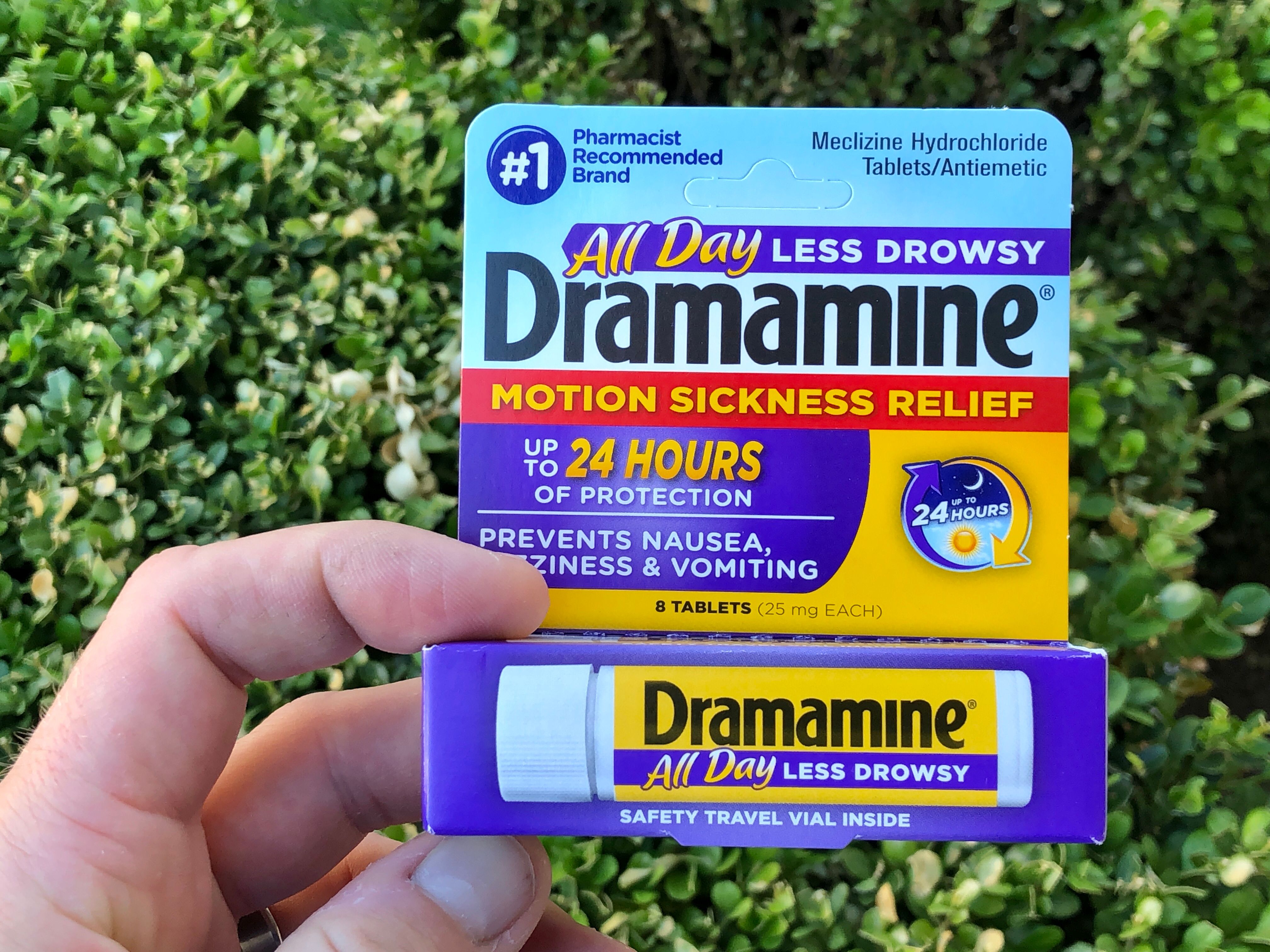
Over-the-counter antiemetic drugs like Dimenhydrinate (Dramamine) and Meclizine (Bonine) are both effective and easily accessible, making them some of the best seasickness medication for cruises.
Dramamine medication for seasickness on cruises works by blocking the signals to the brain that trigger nausea and vomiting. It’s effective for 4-6 hours and should be taken as needed (not exceeding the maximum daily dosage recommended on the package).
While it’s widely recognized as the best medication for motion sickness on a cruise, a common side effect of taking Dramamine for cruises is drowsiness, which may temporarily sideline you from vacation activities. A non-drowsy option is available but isn’t considered to be as effective as the standard formula.
Bonine is another great medicine for cruisers facing motion sickness, hailed for its long-lasting effects ranging up to 24 hours for a once-daily dose. Bonine’s fast-acting relief properties also make it one of the best nausea medicine for cruises that may hit rough, choppy waters unexpectedly.
Like Dramamine, Bonine may cause drowsiness, with additional side effects like dry mouth and headaches. If you’re planning to enjoy alcohol during your cruise, consider other anti nausea for cruise options. Mixing alcohol with Dramamine or Bonine can intensify their side effects significantly.
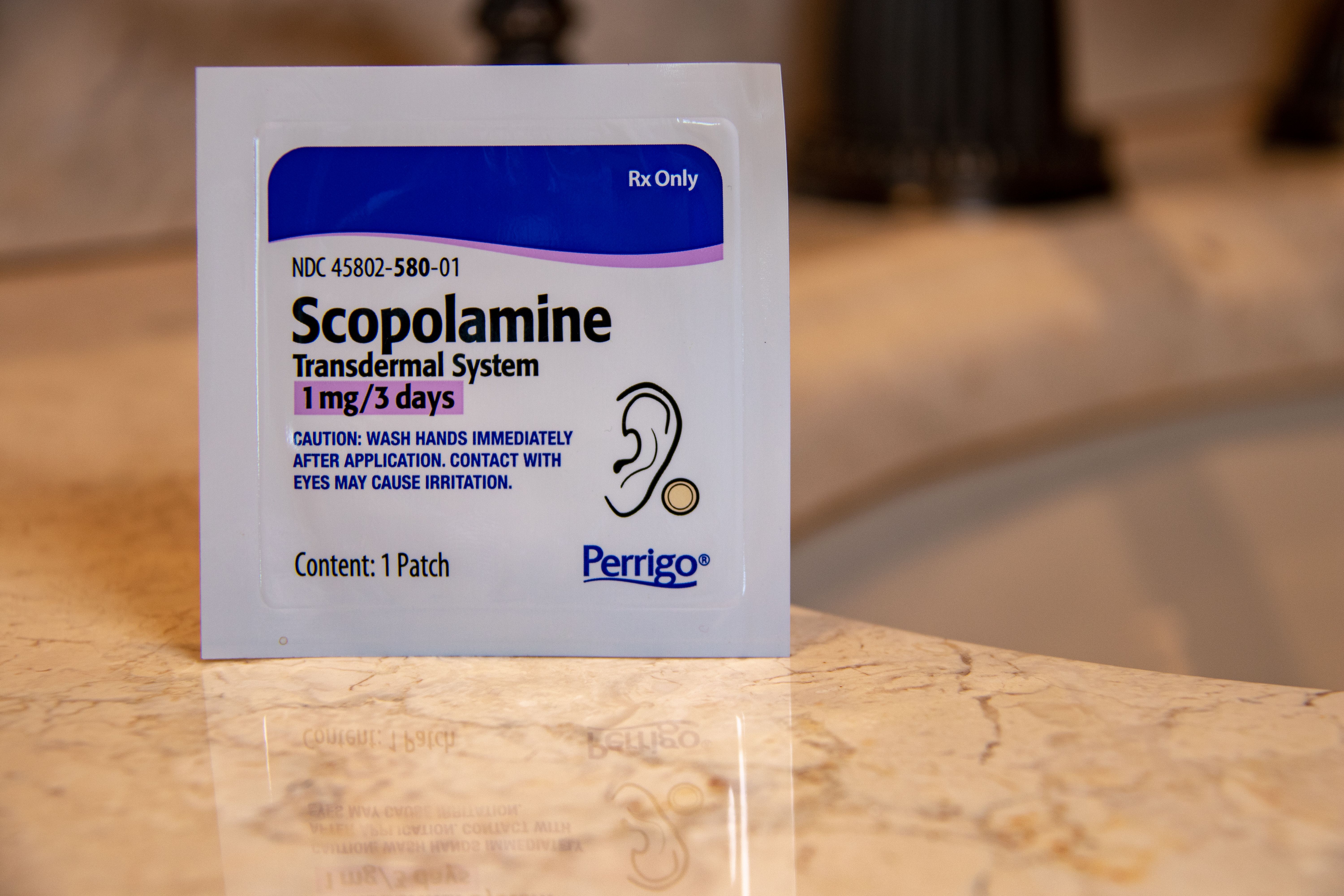
If you’re looking for a more potent medicine for seasickness, cruise patches are an excellent choice. Among patches for motion sickness, cruisers tend to choose Scopolamine over others. This transdermal patch delivers long-lasting relief to your central nervous system and gut when placed behind your ear, working for up to three days after application.
The Scopolamine patch is recommended as the best motion sickness patch for cruisers who’ve experienced moderate to severe seasickness in the past.
Known as the best seasickness patch for cruises for its ease of administration and consistent effectiveness, it’s important to be prepared for possible side effects like dry mouth and dizziness. Consult with your doctor first if you have a history of respiratory, cardiovascular, gastrointestinal, neurological, urological, psychiatric, renal, hepatic, or muscular disorders. Avoid alcohol while using Scopolamine as the combination can heighten side effects.
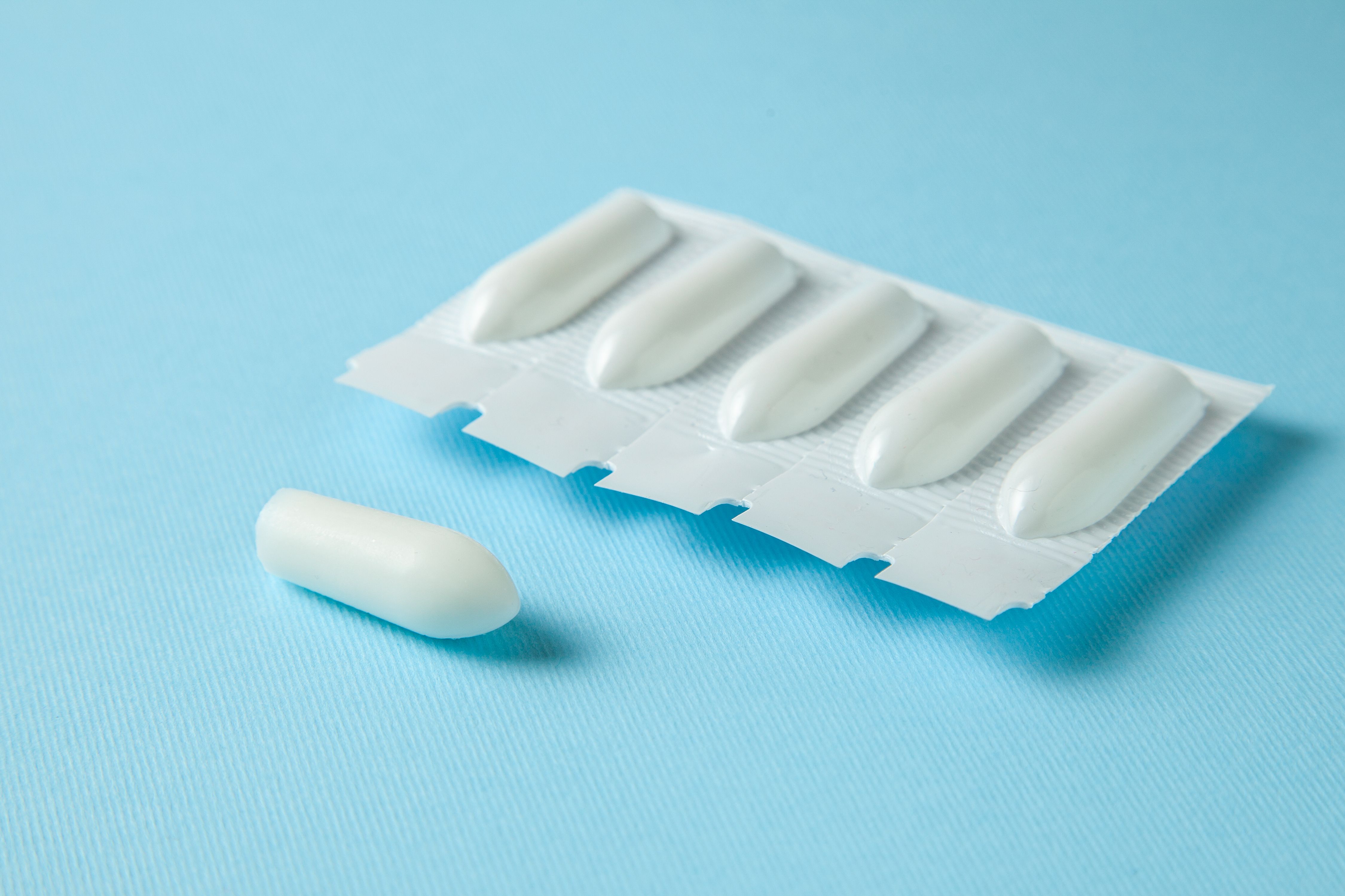
One less commonly prescribed, but arguably the most effective medicine for cruise motion sickness, is physician-administered Prochlorperazine (Compro or Compazine). This suppository is typically available onboard, especially for guests facing severe symptoms such as cold sweats, pallor, and constant vomiting. Your cruise physician can assist with administration up to twice a day.
Prochlorperazine works by quickly targeting and neutralizing substances in your body that cause nausea and vomiting. Its effects usually last about 3 to 4 hours before having to be re-administered. Prochlorperazine is the best seasick medicine for cruisers who can’t hold down food during their cruise, especially children older than 2 years.
Common side effects of Prochlorperazine include dry mouth, drowsiness, headaches, blurred vision, and stuffy nose; however, they are usually mild and go away on their own Prochlorperazine is not recommended if you have a history of blood clots, bowel blockage, or epilepsy. Talk to your cruise physician if you begin to experience nausea or vomiting at sea.
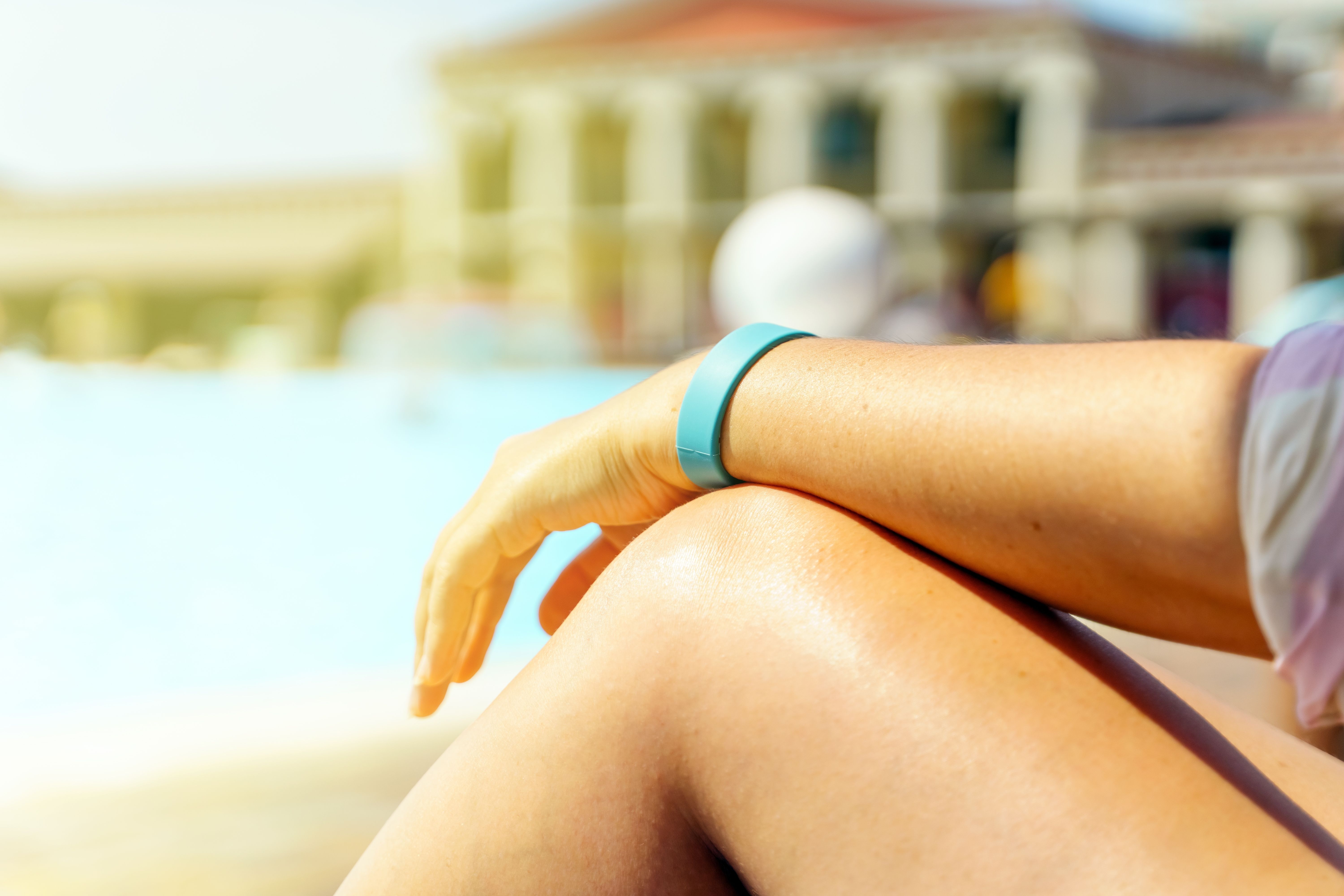
Apart from medicines, motion sickness bands, or acupressure sea-bands, are one of the more gentle seasickness remedies cruisers tend to opt for. Sea Bands for cruises work by pressing a plastic bead against the Nei-Kuan pressure point on your wrist. By hitting that pressure point, the median nerve is stimulated, which disrupts nausea signals from being sent to the brain.
A frequently asked question is “can you wear sea bands overnight”? While the answer is yes, the effectiveness may differ from one person to another.

For some people, natural methods are the best remedies for seasickness on a cruise, with ginger being a popular choice. Ginger works to ease nausea by clearing out your stomach and can be taken in many forms, like candies, teas, or pills.
Essential oils, like peppermint and lavender, complement your natural arsenal by soothing stomach discomfort and promoting overall well-being. Try inhaling these oils through a diffuser to relax the gastric muscles, reduce anxiety, and improve sleep quality.
Many travelers swear by a combination of holistic treatments as the best motion sickness remedy for cruises. Mix and match these remedies to naturally prevent nausea and vomiting without medicine.
Practical Tips on How to Prevent Seasickness on a Cruise
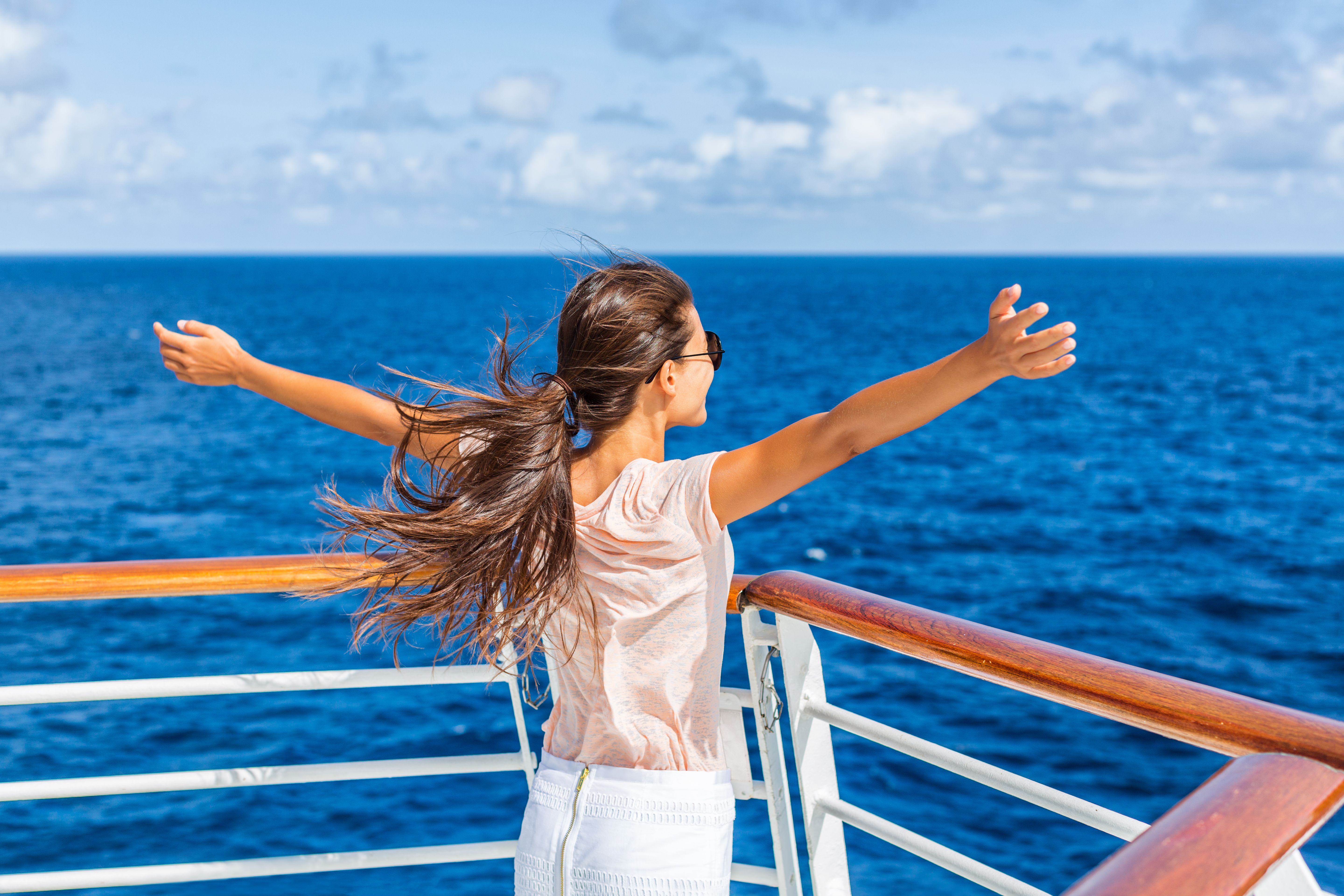
One of the best motion sickness prevention for cruises is to care for your health and well-being while on board, making it easier to have fun and explore. Here's a brief checklist of how to prepare effectively:
- Room Selection : The best cruise rooms for motion sickness are in the middle of the ship and on a lower deck.
- Cruise Cabins to Avoid : Do not book a room at the front or back of the ship, since that is where motion is felt the most.
- Stay Refreshed : Avoid big, rich meals and alcohol. Eat lighter foods in smaller portions, while drinking plenty of fluids. Drink water or drinks with electrolytes, and avoid heavily caffeinated or sugary drinks.
- Eat Green Apples : The pectin in green apples neutralizes stomach acid, and the natural sugars can settle a queasy stomach. Tossing a couple into your diet can make green apples seasickness solutions that are both effective and delicious.
- Get Enough Sleep : Make sure to stay well rested during your cruise. Sleep deprivation can worsen motion sickness symptoms.
- Limit Technology Use : Looking at a screen can worsen motion sickness symptoms. Try to spend as little time on screens as possible well on the ship.
- Avoid Smoking : Smoking can enhance motion sickness symptoms.
Sail Beyond Seasickness
With the best cruise motion sickness medicines on hand, visit Cruisebound to find your next cruise. Whether you opt for a cruise medicine or a non-pharmaceutical remedy for nausea, the world's wonders are yours to explore without the worry of motion sickness.
This is the announcement bar for Poornima to test the Close Button. It will expire May 31 2024.
- Pre-Cruise FAQ
- Onboard FAQ
- Post-Cruise FAQ
- Cruisetours FAQ
- Special Offers Sign Up
- Cruise Deals
You have been logged out
Your window will update in 5 secs
Best Motion Sickness Medicine for a Cruise
The best motion sickness medicine for cruises will be different for everyone. All our ships are well-stabilized and bear plenty of weight so most guests don’t even feel like they’re moving. That said, certain guests may be more prone to feeling motion than others — like they would in a car or plane. While some find relief with devices like patches and wristbands, others prefer drinking water and getting fresh air. Here are some of the best remedies for tackling motion sickness on a cruise.
Bring Nausea Relief
If you’re more sensitive to motion sickness on cruises, stay prepared with store-bought solutions. Some of the most popular products include skin patches and wristbands. Patches are typically placed behind your ear where the medication can more easily absorb into your skin. Since the patches are hidden, you don’t have to worry about them distracting from your dinnerware wardrobe or photos from your shore excursions. Similarly, the bands are worn on the wrist and target pressure points to help stabilize your body. These products are usually waterproof so no need to remove them before enjoying the pools on board.
According to many of our guests, some of the best seasickness tablets for a cruise include Dramamine or Bonine. These medications can be taken before nausea arises to help lessen the severity. They may also be taken to ease the feeling of sickness as it occurs. Be aware that these may cause drowsiness in some guests. Please consult a medical professional to determine whether this is the best solution for you. Whether you want to prevent nausea or help alleviate it in the moment, considering adding all of these therapies to your cruise packing list and stay prepared for any situation.
Step Outside for Fresh Air
One of the easiest ways to relieve nausea while on board is stepping outside to get fresh air. That’s why we recommend booking a room with a balcony to guests who are more prone to feeling motion sickness. Slip outside at any time of the day from the comfort of your stateroom. Or, lie down on your lounge chair undisturbed by other guests. Focus on the refreshing breeze and before you know it you’ll be ready to dive back into onboard activities.
Drink Plenty of Water
Sometimes, a glass of water is the only relief you need. Many guests have shared that regularly drinking H2O during the day helped keep nausea at bay. Whether you’re relaxing poolside or grabbing a slice of the best pizza at sea, there are always refreshments nearby. If you don’t know where to go, just find one of our friendly crew members who will be happy to assist you.
Visit the Lotus Spa®
For the ultimate remedy, retreat to the Lotus Spa® , where skilled therapists can relieve any maladies. Upon visiting the spa, let our staff know what symptoms you’re experiencing and they can recommend the best treatment for you. Experience the healing powers of acupuncture which can precisely target pressure points. Indulge in a relaxing massage to help soothe areas of tension. Or, treat yourself to a hydrating facial and let the feelings of nausea wash away.
All our ships were designed to deliver seamless voyages to every destination. If you’re prone to feeling motion sickness on a cruise, don’t let that get in the way of your world travels. Stay prepared with the best medication for seasickness on a cruise and set sail with Princess.
- Type 2 Diabetes
- Heart Disease
- Digestive Health
- Multiple Sclerosis
- Diet & Nutrition
- Supplements
- Health Insurance
- Public Health
- Patient Rights
- Caregivers & Loved Ones
- End of Life Concerns
- Health News
- Thyroid Test Analyzer
- Doctor Discussion Guides
- Hemoglobin A1c Test Analyzer
- Lipid Test Analyzer
- Complete Blood Count (CBC) Analyzer
- What to Buy
- Editorial Process
- Meet Our Medical Expert Board
Bonine vs. Dramamine: Similarities & Differences
Understanding motion sickness, what is bonine, what is dramamine.
- Dosing Comparison
- Comparative Efficacy
- Prevention Techniques
- Side Effects
Potential for Interaction
Frequently asked questions.
Orally administered Bonine (meclizine) and Dramamine (dimenhydrinate) are two of the most common over-the-counter (OTC) medications used to treat and prevent motion sickness .
Both drugs belong to a drug class called antihistamines . Antihistamines prevent and treat symptoms associated with motion sickness, such as nausea , vomiting , and dizziness .
Generally, while both are considered similar medications, understanding their existing differences, such as differences in their active ingredients and dosing guidelines, can help you choose the proper medication, whether for yourself or a loved one.
This article will conduct an in-depth comparison of Bonine versus Dramamine, comparing their effectiveness, dosing, storage requirements, side effects, and more.
Shironosov / Getty Images
Motion sickness occurs when a person's vision of motion differs from what their inner ear senses. As a result of this discrepancy, nausea, vomiting, or dizziness can occur. Motion sickness can occur in a car, boat, or motor vehicle.
The brain senses movement by receiving signals from your inner eyes, ears, and joints. Motion sickness can occur when these signals conflict and do not match.
Generally, females and children between the ages of 2 and 12 are more prone to motion sickness than other demographics, but the condition can affect anyone.
Some factors that may increase the chances of experiencing motion sickness include:
- History of an inner ear disorder
- Currently pregnant
- Currently taking a birth control medication
- A history of migraines
- Family history of motion sickness
- Currently experiencing menstrual periods
Bonine is an OTC medication that contains the active ingredient meclizine. The Food and Drug Administration (FDA) has approved Bonine for preventing and treating nausea, vomiting, or dizziness caused by motion sickness.
Bonine is a chewable tablet approved for adults and children 12 and older. Children under 12 shouldn’t be given Bonine without consulting a pediatrician or other healthcare professional.
In addition to being available as a generic product, Meclizine is also available as a prescription (Rx) drug called Antivert. Healthcare providers may prescribe Antivert for other conditions that cause dizziness, such as vertigo .
Besides motion sickness, Bonine may be used more broadly for its antiemetic (anti-nausea) effects.
While not explicitly approved for this purpose, healthcare providers may recommend Bonine off-label to prevent or lessen nausea and vomiting from other causes, such as viral infections or headaches .
How Does Bonine Work?
Bonine works to prevent symptoms of motion sickness by blocking histamine receptors. When histamine binds to specific receptors, vomiting (emesis) can occur. Bonine, an antihistamine, mainly works by blocking histamine from binding, which helps to prevent and ease nausea.
It takes about an hour to start working. For this reason, it would be best to take your dose one hour before doing an activity that triggers motion sickness, such as riding in a car or boat.
Bonine is typically taken once a day; meclizine’s anti-nausea effects last up to 24 hours.
Oral Dramamine is an over-the-counter (OTC) medication that contains the active ingredient dimenhydrinate. The FDA approves Dramamine to relieve nausea, vomiting, and dizziness caused by motion sickness.
OTC Dramamine comes in two forms of administration: a swallow tablet and a chewable tablet. And this drug is approved for adults and children 2 and older.
Healthcare providers may also recommend Dramamine to treat or prevent nausea and vomiting from other causes.
Note that different versions of Dramamine are available. Brand-name products like Dramamine for Kids and Dramamine Original contain dimenhydrinate.
Other versions, such as Dramamine Less Drowsy, contain meclizine instead of dimenhydrinate (the same active ingredient as Bonine).
In addition, a “non-drowsy” version of Dramamine is also available. It contains ginger and does not contain an antihistamine ingredient. Be sure to read the product labels or consult a pharmacist to help find the product you’re looking for.
Finally, like Bonine, a generic version of Dramamine exists.
How Does Dramamine Work?
Like Bonine, Dramamine blocks histamine receptors in the body, resulting in anti-nausea effects.
Dramamine starts working within 30 to 60 minutes. You should take it half an hour to an hour before travel or other motion-sickness-causing activity.
Each dose lasts between four to eight hours. Unlike Bonine, Dramamine may be taken multiple times throughout the day if needed.
Dosing Comparison: Bonine vs. Dramamine
When taking either drug, follow the directions on the label, and ask a healthcare provider to explain anything you don't understand. Bonine and Dramamine should be taken as directed, meaning you shouldn't take more than what is recommended.
Additionally, be aware that the chewable tablets may be chewed or swallowed whole.
The table below compares the dosage forms, strengths, and recommended dosages of Bonine and Dramamine for adults and children:
Which Is More Effective?
Few studies directly compare Bonine vs. Dramamine.
In the early 1980s, NASA researchers compared different medications to prevent motion sickness, including dimenhydrinate (Dramamine) and meclizine (Bonine). They tested the drugs in situations that induce motion sickness, such as sea travel, air travel, and zero-gravity flights.
The researchers confirmed that both drugs effectively increased a person’s resistance to motion sickness. Ultimately, Bonine effectively prevented motion sickness due to mild motion, such as car travel, while Dramamine was effective against moderately intense motion.
The researchers did not recommend either drug for severely intense motion. Likewise, neither drug was found to be effective after motion sickness already developed.
This study suggests that individuals prone to motion sickness should take anti-nausea medication up to an hour before exposure to motion for best results. Taking Bonine or Dramamine when you already feel carsick is not as effective as taking it beforehand.
Dimenhydrinate starts working as soon as 30 minutes after you take it. This is a bit faster than meclizine, which requires about an hour to take effect. However, dimenhydrinate’s anti-nausea effects wear off faster. Dimenhydrinate lasts four to eight hours, while meclizine lasts up to 24 hours.
The details of the situation may determine which medication is a better option. For example, if one person intends to board a boat 30 minutes from now, the faster onset of dimenhydrinate makes it a better choice than meclizine.
However, if another person plans to board a long flight in an hour and hopes to avoid needing more doses while on board, meclizine is an ideal choice.
Talk to a pharmacist or healthcare provider for assistance choosing the best option to prevent motion sickness.
Preventing Motion Sickness and Vertigo
Various non-drug approaches exist to help prevent and limit motion sickness and vertigo. Experts recommend the following methods:
- Breathing techniques. Breathing exercises can help with motion sickness or vertigo. It alters your focus onto something other than movement, helping prevent motion sickness.
- Face forward . Conflicting senses, such as facing backward while riding on a train or subway, often lead to symptoms of motion sickness. Choosing a forward-facing seat may provide relief or prevent symptoms.
- Look at the horizon. Synchronizing the visual system by focusing on a single, unmoving point can help reduce head and eye movements, easing dizziness and nausea.
- Natural remedies . Various dietary supplements, such as ginger and vitamin C , may provide benefits in managing nausea due to motion sickness.
- Fresh air. Airflow can help ease nausea and distract you from feeling sick. Try putting down the car windows or pointing the air vents toward you.
Side Effects & Safety
Bonine and Dramamine share a similar set of side effects.
Common side effects of both Bonine and Dramamine are usually mild and may include:
- Decreased urination
- Blurred vision
- Constipation
Notably, both Bonine and Dramamine may cause drowsiness. However, Dramamine (dimenhydrinate) typically causes more severe drowsiness than Bonine (meclizine).
Precautions
Bonine and Dramamine may not be safe for individuals with certain medical conditions.
Discuss motion sickness treatment options with a healthcare provider before taking Bonine or Dramamine if you have:
- Any type of glaucoma
- Asthma or other breathing problems, such as emphysema or chronic bronchitis
- Trouble with urination due to an enlarged prostate
If you are pregnant or breastfeeding, talk to a healthcare professional before taking either Bonine or Dramamine for motion sickness. They can help determine if these medications are safe for you.
Dramamine and Bonine can cause drowsiness. This side effect can be worsened if either drug is taken with other medications or substances that cause drowsiness.
Examples of drugs or substances known to cause drowsiness to be avoided while taking Bonine or Dramamine include:
- Insomnia medications, such as Ambien (zolpidem) or Lunesta (eszopiclone)
- Anti-anxiety medications, such as Xanax (alprazolam) or Ativan (lorazepam)
- Opioid pain medications , such as Oxycontin (oxycodone) or MS Contin (morphine)
- Other drugs that contain antihistamines, such as OTC cough medicines or sleep aids
Bonine and Dramamine are similar OTC medications for motion sickness. Dramamine contains dimenhydrinate, which starts working more quickly but causes more drowsiness.
Bonine contains meclizine, which provides long-lasting effects and is associated with less drowsiness.
They are both effective for preventing symptoms of nausea, vomiting, or dizziness if taken early enough. Taking either drug up to an hour before starting the activity that triggers motion sickness is essential.
Bonine and Dramamine require no special storage considerations while traveling. Store them in a closed container at room temperature (between 68 and 77 degrees F), away from moisture.
Dramamine requires more frequent dosing than Bonine, so keep it handy (e.g., not in your checked luggage) if traveling for more than four hours.
There isn’t much of a cost difference between Bonine and Dramamine. Generally, it costs around $10 for either a 16-count pack of Bonine chewable tablets or an 18-count pack of Dramamine chewable tablets.
Depending on how long you’ll be exposed to motion, remember that Dramamine is taken every four to eight hours, while Bonine is taken once daily.
Possibly. Dizziness can sometimes indicate a problem with the inner ear, which helps control balance.
Talk to a healthcare provider if motion sickness medications and other methods aren’t helping. They will check for other possible causes.
MedlinePlus. Meclizine .
MedlinePlus. Dimenhydrinate .
MedlinePlus. Motion sickness .
Centers for Disease Control and Prevention. CDC Yellow Book 2024: motion sickness .
DailyMed. Label: Bonine- meclizine hydrochloride tablet, chewable .
DailyMed. Label: Meclizine 25- meclizine hydrochloride tablet, chewable .
DailyMed. Label: Antivert- meclizine hcl tablet Antivert- meclizine hcl tablet Antivert- meclizine hcl tablet, chewable .
National Institute of Diabetes, Digestive, and Kidney Diseases. Antiemetic agents. Liver Tox. 2018.
DailyMed. Label: Dramamine for Kids- dimenhydrinate tablet, chewable .
DailyMed. Label: Dramamine original formula- dimenhydrinate tablet .
DailyMed. Label: Dramamine Less Drowsy- meclizine hydrochloride tablet .
Prestige Consumer Healthcare. Dramamine products .
DailyMed. Label: Dimennhydrinate tablet .
DailyMed. Label: Dramamine- dimenhydrinate tablet, chewable .
Wood, CD, Cramer, DB, Graybiel, A. Antimotion sickness drug efficacy. Otolaryngol Head Neck Surg. 1981;89(6):1041-1044. doi:10.1177/019459988108900632
Koch, A, Cascorbi, I, Westhofen, M. The neurophysiology and treatment of motion sickness. Dtsch Arztebl Int. 2018;115(41):687-996.
By Patricia Weiser, PharmD Patricia Weiser, PharmD, is a licensed pharmacist and freelance medical writer. She has more than 14 years of professional experience.
Thanks for visiting! GoodRx is not available outside of the United States. If you are trying to access this site from the United States and believe you have received this message in error, please reach out to [email protected] and let us know.
Bonine vs Dramamine: Which is the Best Motion Sickness Medicine on a Cruise
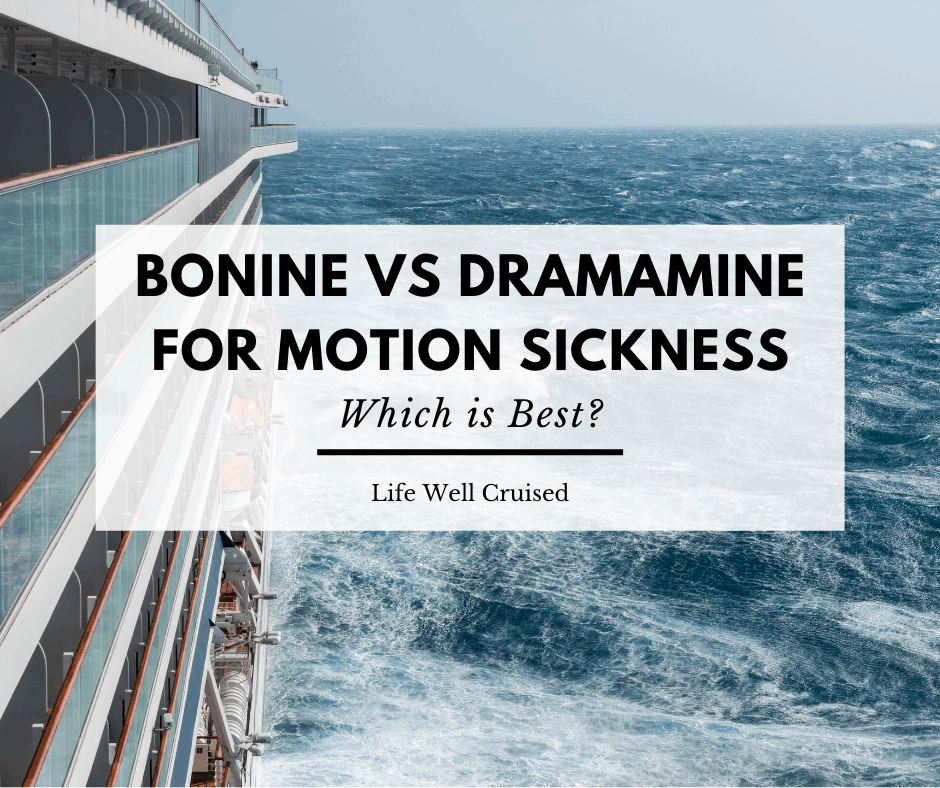
Sharing is caring!
If you’re prone to motion sickness, then you’ve likely wondered which medication is best for treating the symptoms. Bonine and Dramamine are both popular medications that work well at relieving nausea and other symptoms associated with motion sickness.
Although there are both natural and pharmaceutical ways to deal with for seasickness on a cruise , motion sickness pills are convenient and effective. In this post we’ll compare Bonine and Dramamine, and answer some of the questions you may have.
Please note that this post isn’t intended as medical advice. If you have concerns or a medical condition, please consult with your doctor or pharmacist.
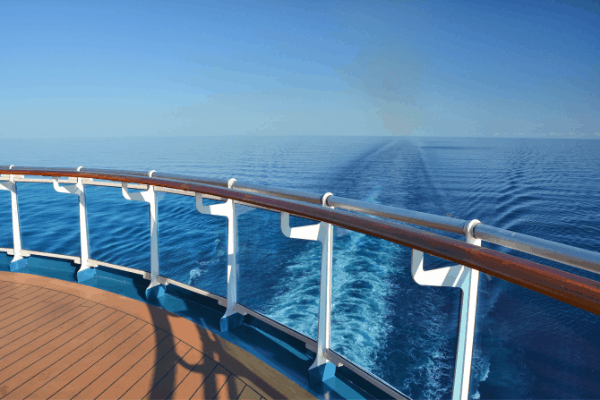
This post contains affiliate links which means if you click and buy that I may make a commission, at no cost to you. Please see my disclosure policy for details.
As an Amazon Associate I earn from qualifying purchases.
How Do Bonine and Dramamine Work?
Both Bonine and Dramamine are effective medications to relieve motion sickness symptoms. Both medications contain antihistamines, which have been found to be effective in warding off nausea associated with motion sickness.
Dramamine and Bonine both start working within 30 minutes of taking them, however it’s even better to take them before motion sickness sets in. If seas are rough or you’re prone to motion sickness, taking them preventatively is a good idea.
Which is Better for Motion Sickness, Bonine or Dramanine?
Dramanine original formula.

Dramamine’s original formula prevents and relieves dizziness, nausea and vomiting, all awful symptoms of motion sickness. The active ingredient is dimenhydrinate. Some people report feeling drowsy and foggy when they take Dramamine Original Formula.
To prevent seasickness, a first dose should be taken 1/2 to 1 hour before a boat ride, cruise or when you think you may need it. After, it’s suggested to take 1 to 2 tablets every 4-6 hours, not exceeding more than 8 tablets in 24 hours.
Recommended: Dramamine Original Formula (see over 7000 Amazon reviews)
Dramanine’s Less Drowsy Motion Relief

The active ingredient in Dramamine’s Less Drowsy Motion Relief is Meclizine Hydrochloride, so it won’t leave you feeling drowsy the way the original formula might. It’s available in chewable form and lasts up to 24 hours.
Recommended : Dramamine Less Drowsy Motion Relief (see reviews and check pricing on Amazon here)

The active ingredient in Bonine is Meclizine hydrochloride. It’s suggested to take a pill about an hour before travel starts, and it can be taken once to twice a day after this. Bonine is a chewable pill so you can take it anytime, without water or liquids. However, if you don’t like chewables, you can swallow it without chewing as well.
Many cruisers who are prone to motion sickness, take one pill daily to prevent seasickness before it occurs.
According to the manufacturer, the once-a-day travel tablet prevents motion sickness and causes less drowsiness than original Dramamine and lasts up to 4 times longer.
Recommended: Bonine Motion Sickness Medication (check pricing and see Amazon reviews here)
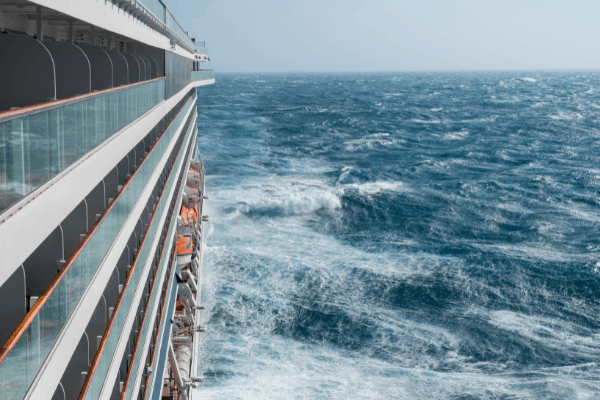
What’s the Difference Between Dramamine and Bonine?
Dramamine’s original formula’a active ingredient is dimenhydrinate and this medication needs to be taken every 4-6 hours. Bonine’s active ingredient is Meclizine and one pill lasts up to 24 hours.
Is Bonine Better Than Dramamine?
Although it’s a personal decision and both medications are effective in relieving symptoms of motion sickness, some people report feeling drowsy, foggy or “out of it” when they take Dramamine, not the best feeling when you want to enjoy your cruise.
In our family, we’ve taken both Dramamine’s original formula and Bonine, and felt better and more functional and “normal” when taking Bonine. Of course, this remains a personal decision and you can speak with your doctor or pharmacist for more advice.
Do Natural Remedies Work to Prevent Seasickness?
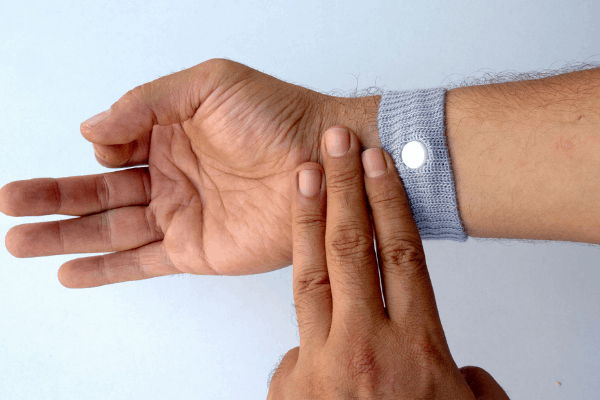
Yes, there are a number of natural remedies that can be effective in aiding motion sickness. Ginger works for many people because it has anti-nausea properties and is available in pill form, capsules and as ginger candy . It also doesn’t come with the side effects associated with taking medication.
Another alternative is acupressure wristbands or bands that are applied to acupressure points on the face. Many avid cruisers use Seabands and find them quite helpful to ease and prevent motion sickness on the cruise ship and boat excursions.
Read next: How to Prevent Seasickness on a Cruise: 10 Effective Remedies
Get The Ultimate Cruise Planner
Regular price: $27 now just $17.
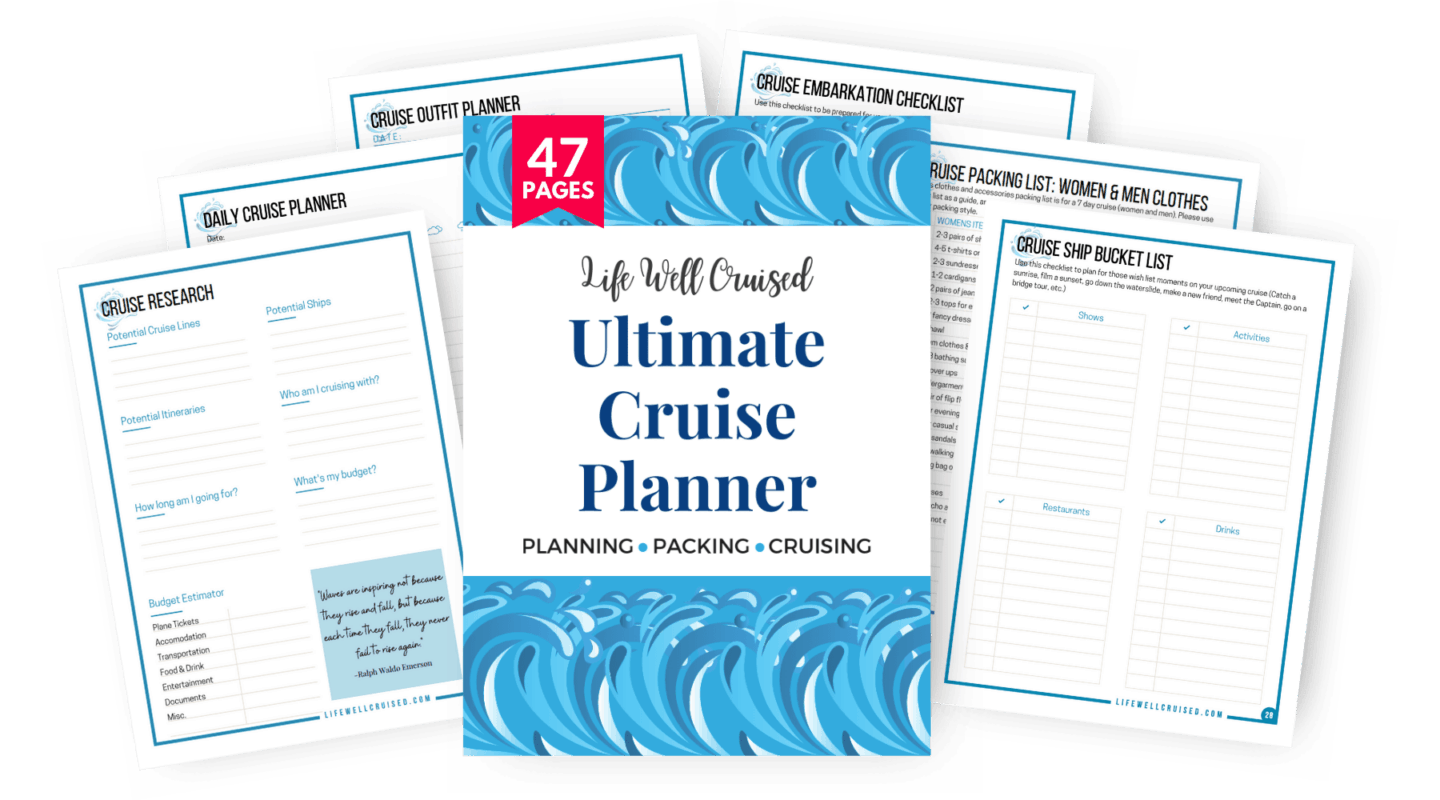
Related & Popular Posts:
What to Pack for a Caribbean Cruise (full packing list included)
Best Travel Gadgets to Bring on a Cruise (tech items & electronics)
50 Best-selling Amazon Items to Bring on a cruise
27 Cruise Packing Mistakes You Might Be Making
20 Cruise Packing Tips all Cruisers Need
What Food and Drinks Can You Bring on a Cruise?
25 Cruise Embarkation Tips and Secrets
First Aid Kit Essentials to Bring on a Cruise
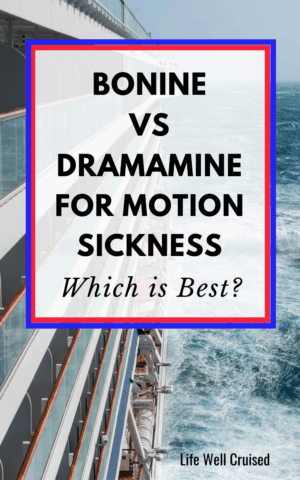
Final Thoughts: Bonine vs Dramamine for Motion Sickness on a Cruise
I hope that this article has helped you answer your question about which medication is better for motion sickness, Bonine or Dramamine.
Please let me know if you’ve taken these medications, have questions or if you use other remedies for seasickness prevention.
Happy Cruising!!
P.S. If you found this helpful, please don’t keep it to yourself ;-). Please share on Facebook or PIN to your favorite Pinterest board (share buttons at the top). Thanks so much!
Let’s connect:
Join me on Facebook at Life Well Cruised
Join me on YouTube at Life Well Cruised
Join me on Pinterest at Life Well Cruised
Join me on Instagram at Life Well Cruised
Leave a Reply Cancel reply
Your email address will not be published. Required fields are marked *
This site uses Akismet to reduce spam. Learn how your comment data is processed .

- Multihull Sailor
- Real Estate
- Maintenance & Hardware
- Water Sports
Fight Off Nausea With the Best Sea Sickness Medicines
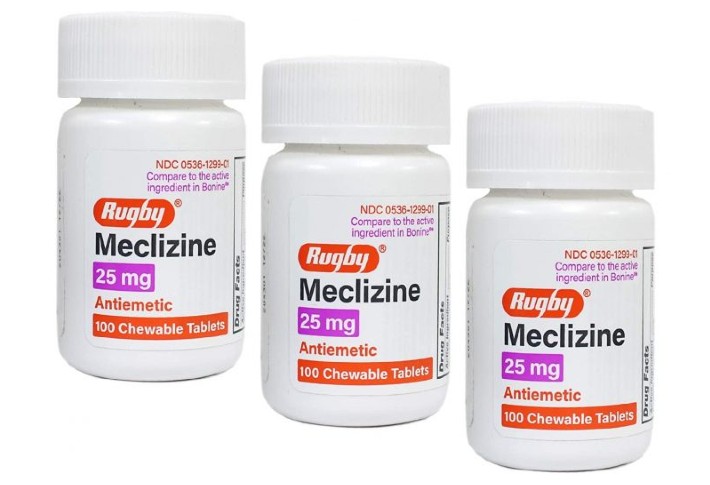
If you're going on a cruise, seasickness can be a major problem. There are many preventative measures you can take to mitigate this issue including wearing an eye patch to reduce visual stimulus, staying hydrated, and using ginger supplements, but sometimes these aren't enough. If you want to enjoy your trip to the fullest, you need sea sickness medication.
These medicines help reduce the symptoms of nausea and vomiting while calming your stomach, making it easier for your body to cope with any movement that may occur while sailing at sea. We’ve compiled a list of some of the great sea sickness medicines of 2024 that can help with your next trip at sea.
Our Top Picks
- Best Overall: Dramamine Sea Sickness Medicine Shop Now ➔
- Amazing Flavor: Bonine Sea Sickness Medicine Shop Now ➔
- Great Value: Rugby Sea Sickness Medicine Shop Now ➔
- Most Versatile: Sea-Band Sea Sickness Medicine Shop Now ➔
- Budget-Friendly: Equate Sea Sickness Medicine Shop Now ➔
- 1 Types of Sea Sickness Medicines
- 2 Prescription medicines
- 3 Over-the-counter medicines
- 4 Homeopathic sea sickness medicines
- 5 Tips for Using Sea Sickness Medicines Effectively
- 6 Avoid looking in the opposite direction
- 7 Look outside the window
- 8 Switch places
- 9 Get some fresh air
- 10 Distract yourself
- 11 Pick your seat carefully
- 12 Eat healthy food before traveling
Can I use an over-the-counter antihistamine?
Can i use any motion sickness medicines to keep sea sickness at bay, do sea sickness medicines actually work, related reviews, finest sea sickness medicine of 2024 reviewed in detail, best overall.
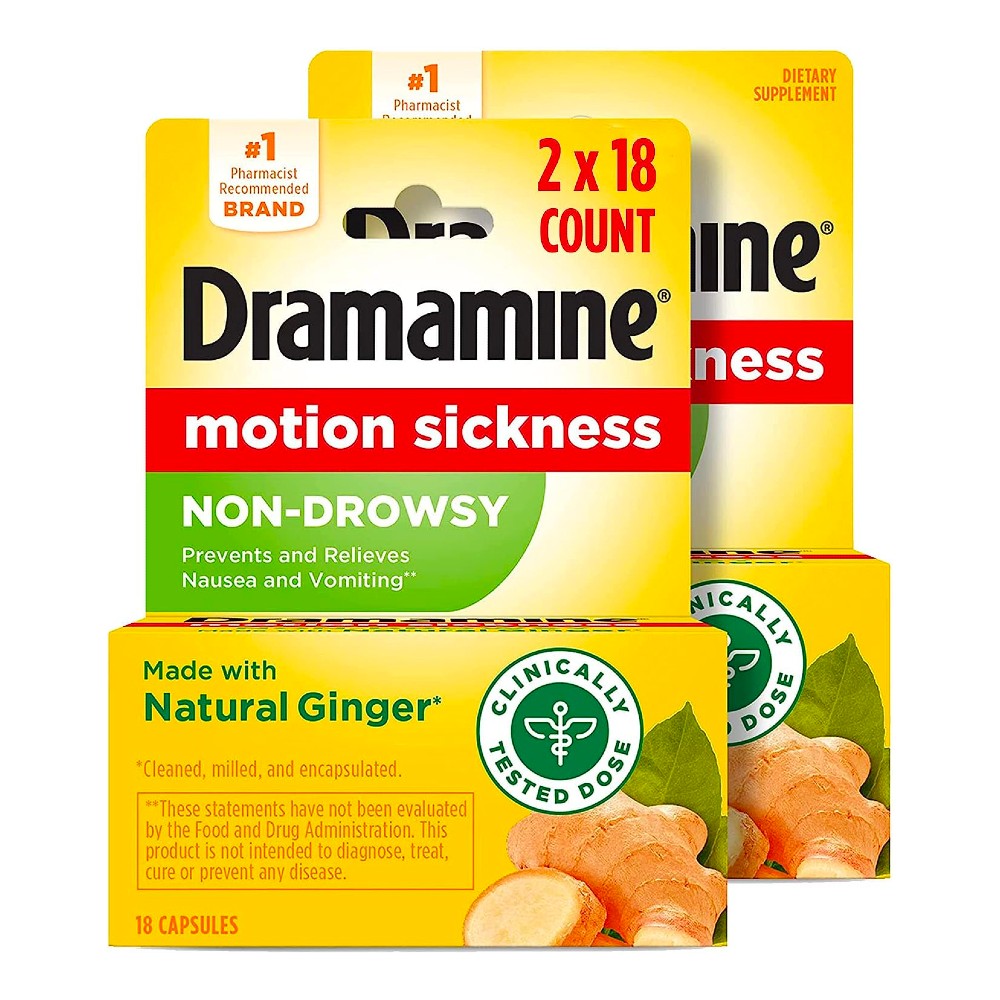
Dramamine Sea Sickness Medicine
Dramamine Sea Sickness Medicine is the number one doctor-recommended medicine that combines the clinically-tested ginger dosage with non-drowsy active ingredients to soothe an upset stomach quickly, so you can enjoy your cruise without any worries. Infused with natural ginger, this sea sickness medicine helps prevent nausea, vomiting, and dizziness associated with motion sickness.
Free from artificial colors and flavors, it’s safe for children and is non-addictive, making it a good option for long-term use. This sea sickness medicine comes in tablet form, so you can just swallow it with some water. With its safe formula and amazing results, this sea sickness medicine has earned the top spot on our list.
- Provides fast relief without any side effects
- Made with natural ginger
- Contain 36 capsules per pack
- Some may not like the ginger taste
Amazing Flavor
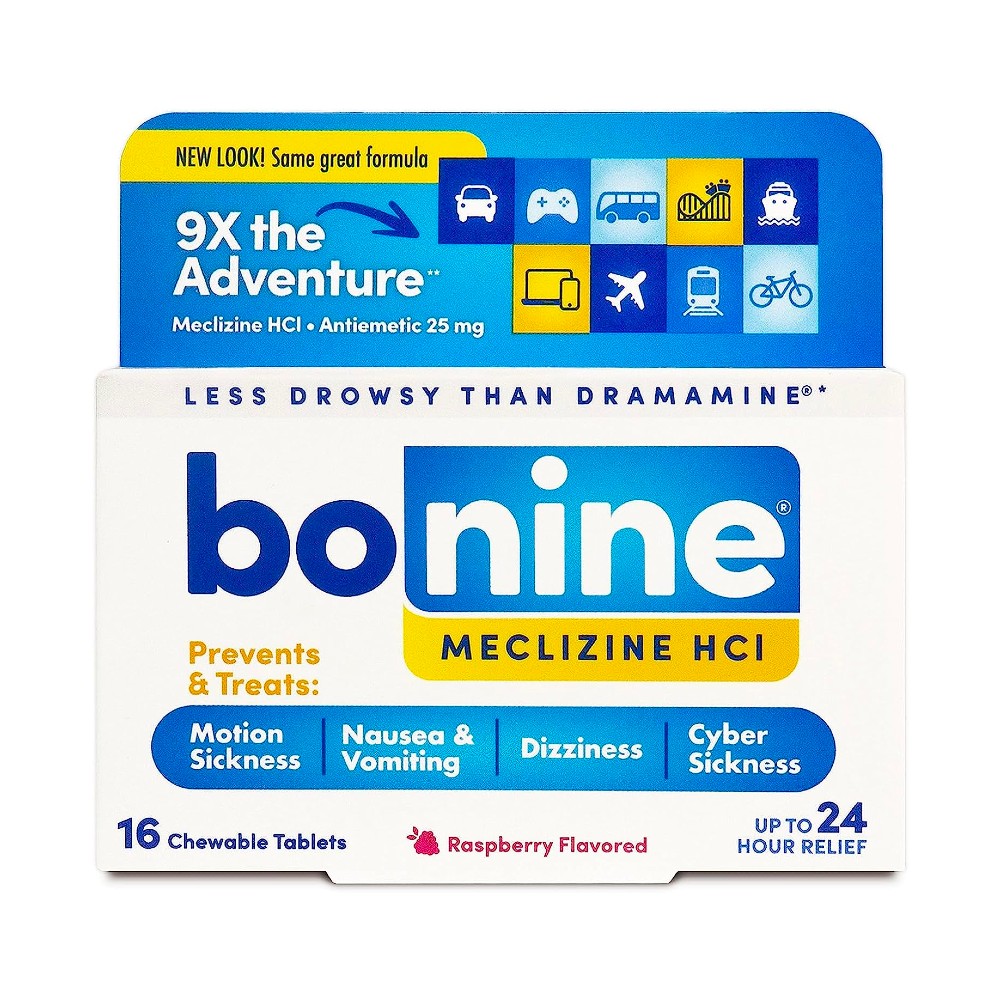
Bonine Sea Sickness Medicine
Don’t let motion sickness ruin your trip! Instead, consider taking Bonine Sea Sickness Medicine. Formulated with meclizine hydrochloride, a safe and effective antihistamine, this medicine mitigates the effects of vomiting, nausea, and vertigo. Because it causes minimal drowsiness, you can even use it before road trips or flights.
This sea sickness medicine works within an hour and offers motion sickness relief for up to 24 hours so you can keep your wits about you even if the waves start to get rough. Suitable for both kids and adults, this sea sickness medicine won’t make you drowsy or cause headaches. It comes in chewable tablets and has a fruity flavor, so it’s easy for anyone to take.
- Offers up to 24 hours of relief
- Safe for kids 12 years and older
- Comes in a fruity raspberry flavor
- Might cause dry mouth
Great Value
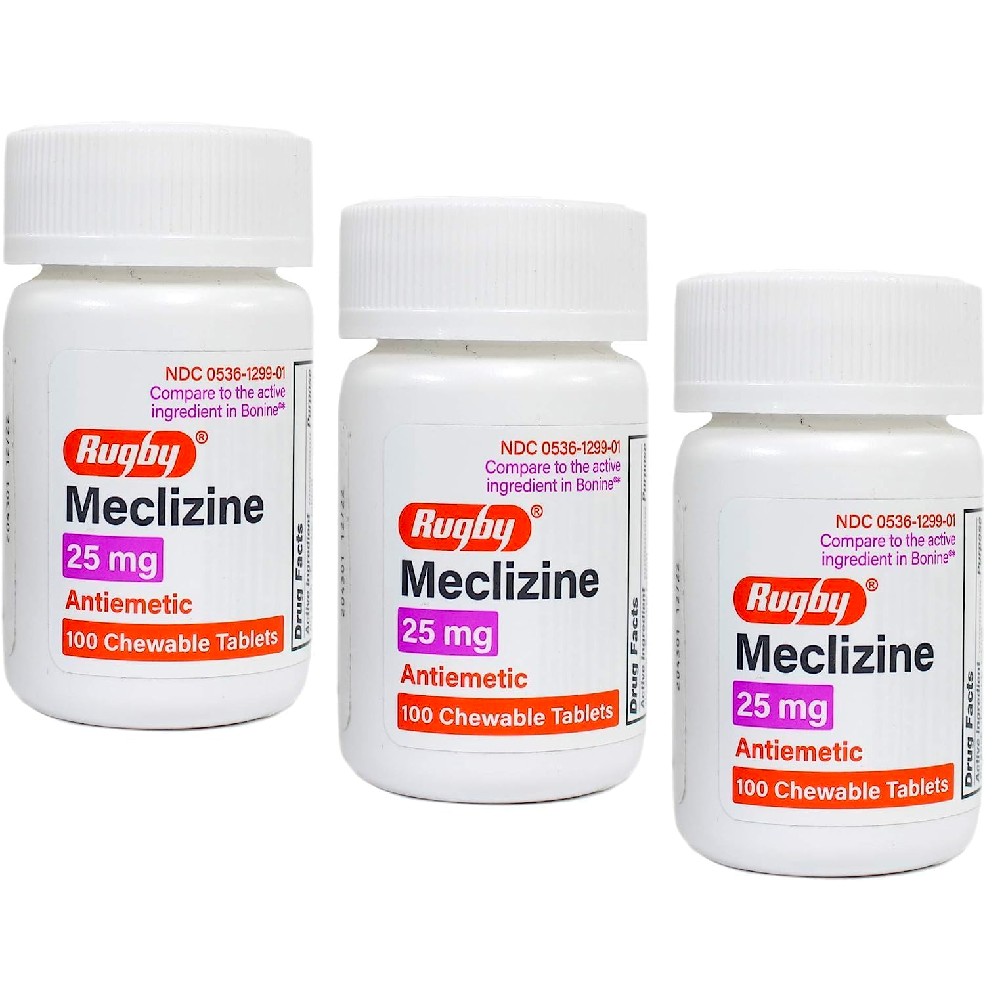
Rugby Sea Sickness Medicine
The Rugby Sea Sickness Medicine is the perfect addition to your travel first aid kit — whether you’re on the water, flying, or driving cross-country. Featuring 25 mg of meclizine HCL, this sea sickness medicine blocks the action of acetylcholine in the brain, preventing nausea, vomiting, and dizziness while calming the stomach.
Available in a package of three containers with 100 tablets each, this sea sickness medicine is enough to get you through your next cruise or long plane ride without feeling sick to your stomach. If you’re taking other medication that includes meclizine as one of its ingredients then make sure this sea sickness medicine doesn’t conflict with your current regimen.
- Comes in a pack of three
- Available at an affordable price
- Chewable tablets are easy to take
- Might be a bit bitter
Most Versatile
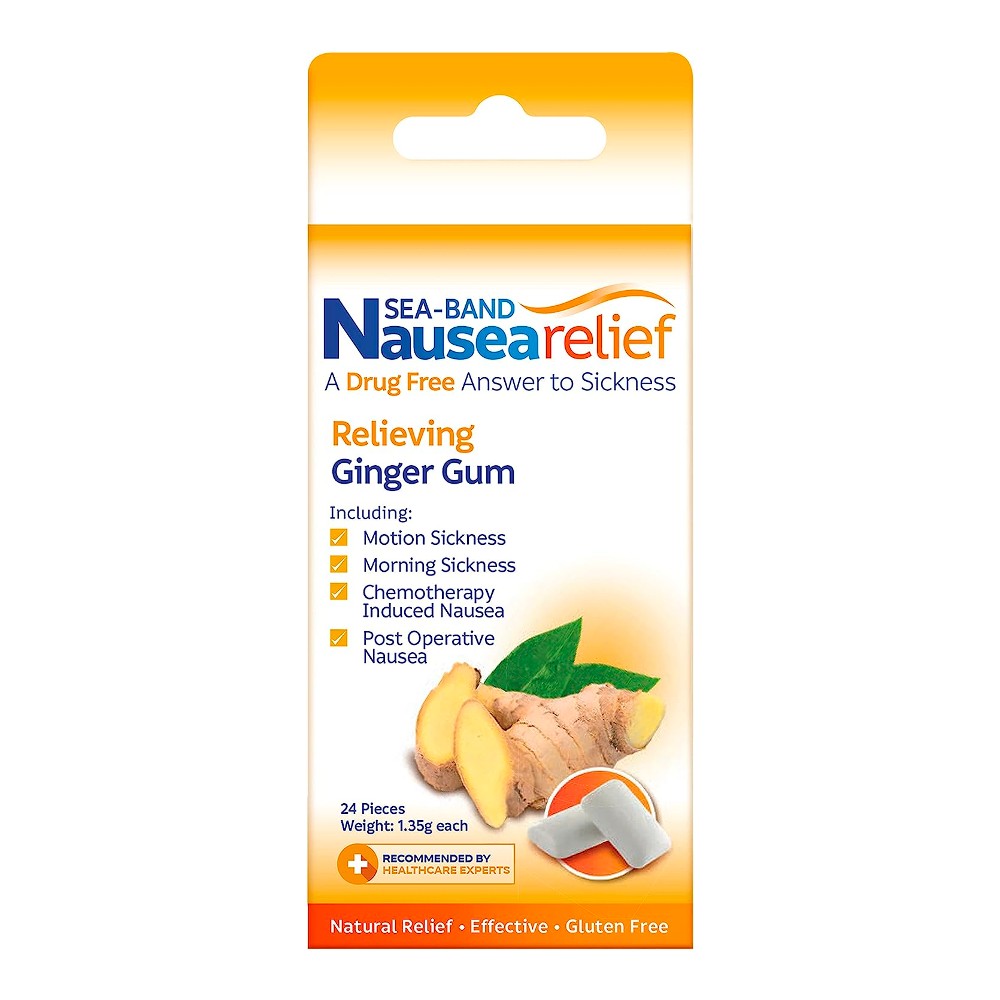
Sea-Band Sea Sickness Medicine
If you’re looking for a way to combat seasickness, Sea-Band Sea Sickness is your best bet. Made with natural ginger, this sea sickness medicine helps with morning sickness, chemotherapy-induced nausea, and post-operative nausea, so you can get through these difficult moments of life with ease.
Formulated with non-drowsy ingredients, it won’t cause side effects and can be used before you even feel sick, making it a great preemptive measure! Available in a pack of 24 gummies, this sea sickness medicine comes in convenient packaging, making it easy to carry with you on your next adventure.
- Works immediately for seasickness
- Provides migraine and anxiety relief
- Soothing ginger flavor
- Might wear off quickly
Budget-Friendly
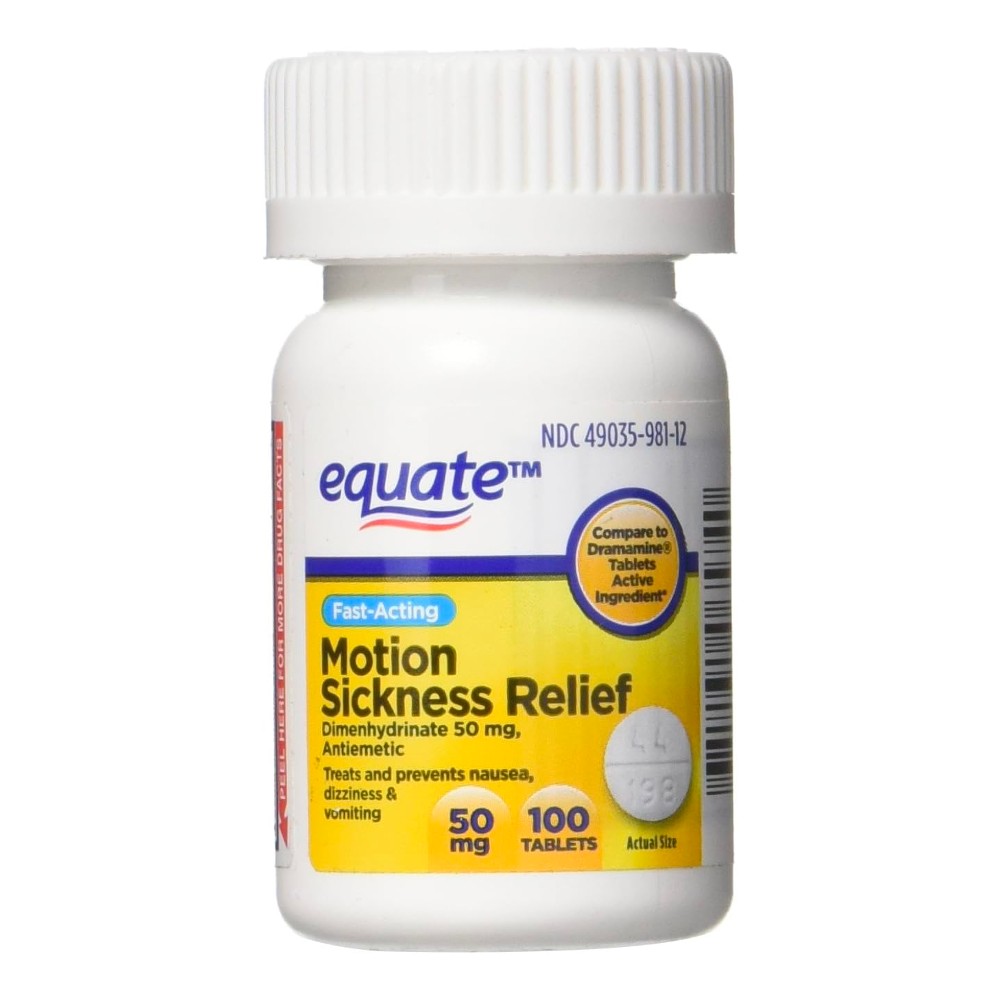
Equate Sea Sickness Medicine
When you’re out on the water, or just traveling by car, train, or plane, it can be hard to keep yourself from feeling sick. But with the Equate Sea Sickness Medicine, you’ll be able to stay upright and alert through it all. Available in a bottle of 100 tablets, each pill contains 50 mg of dimenhydrinate, which works by blocking histamine receptors in your body, helping to relieve nausea and vomiting caused by motion sickness.
These tablets are safe and effective, and they come at a price that’s hard to beat. You must follow the directions on the package closely when taking this medication and do not exceed the recommended dosage or use more than one dose at a time without first consulting your doctor.
- Convenient and easy to use
- Safe, fast-acting formula
- Available over the counter
- Great for short trips
- Might be hard to swallow
Buying Guide to Finding Sea Sickness Medicine
While there are prescription medicines that can treat motion sickness, mild to severe episodes can be treated with over-the-counter medicines. But how do you choose the right sea sickness medicine when there are so many options available? We’ve put together this detailed buying guide to simplify your choice so you can pick the perfect sea sickness medicine for your needs.
Types of Sea Sickness Medicines
Prescription medicines.
For many people, prescription scopolamine transdermal strips or pills can effectively treat seasickness. While scopolamine minimizes nausea and headaches, it might not be an ideal choice for those with glaucoma, urinary tract problems, gastrointestinal system issues, or breathing problems.
Over-the-counter medicines
Many people find that they can control or completely eliminate the unpleasantness of sea sickness by taking over-the-counter antihistamines, which you can purchase without a doctor’s consultation or prescription. You shouldn’t take any strong antihistamine before driving because it may cause sleepiness, sore throat, trouble urinating, and impaired vision. Even though these side effects are often mild, they can put your life in danger if you’re driving on your own.
We recommend taking an antihistamine roughly half an hour before boarding a plane or heading out on a cruise if you’re prone to seasickness. The efficacy of the antihistamine is significantly decreased if you wait until you feel nauseous before taking it.
Homeopathic sea sickness medicines
The idea behind homeopathic remedies is that even small doses of medicine might actually help cure the symptoms. Although homeopathy is not well supported by science, many individuals report feeling better after using them. Numerous homeopathic remedies for motion sickness often contain nux vomica, an extract from the nux vomica tree’s nuts. If you’re allergic to nuts, these might not be the ideal choice for you.
Tips for Using Sea Sickness Medicines Effectively
Avoid looking in the opposite direction.
While many people benefit from sea sickness medicines, the greatest therapy is to prevent sea sickness in the first place. Always look the same way you’re moving and avoid sitting on backward-facing seats on boats, trains, or buses.
Look outside the window
For many individuals, looking at a novel, tablet, smartphone, or other stationary objects inside a moving vessel — such as a boat or bus — makes them feel sick. Instead, you should look at the surrounding beauty or turn your eyes to the sky to avoid motion sickness.
Switch places
While some people feel better standing up, others feel better lying down. If you’re unsure which position suits you best, you should try switching positions whenever you can to see if one feels better than another.
Get some fresh air
If you’re traveling on a cruise that offers open-air seating, try to sit there. You can also try moving onto the boat’s deck since fresh air helps prevent sea sickness.
Distract yourself
Try to talk to someone, listen to music, enjoy the view, or meditate to distract yourself from feeling sick.
Pick your seat carefully
Sit in the most stable position possible in your means of transportation if you usually feel sea sick. We recommend avoiding sitting on the lower decks of a cruise ship. You should also avoid the stern of a smaller boat, which may be more stable than the front, but has a pungent fuel smell that may make you feel uncomfortable.
Eat healthy food before traveling
Avoid fatty, acidic, or heavy foods before your travel, and limit your alcohol consumption. Drink water or fizzy beverages to stay hydrated while traveling, which may help control or mitigate your feelings of sea sickness.
People Also Asked
Absolutely, but be sure to choose the medicine wisely. While the majority of healthy people may use over-the-counter antihistamines without any issues, those who have hypertension, thyroid issues, glaucoma, bladder infections, an enlarged prostate, or renal illness should consult a doctor first.
Traveling on the water may cause more turbulence than traveling on the road or in the air, so it’s best to consult with your pharmacist and choose an over-the-counter medicine that’s known for controlling or treating sea sickness specifically.
Sadly, there is no proven method of treating sea sickness that always works. Although most individuals feel better after using these medicines, some patients get little benefit from them. Numerous research supports the fact that antihistamines provide relief to many people.
Article Contributors
Sail magazine review team.
SAIL Magazine Review Team reports on best-selling products in sailing and boating. SAIL Magazine is reader-supported: When you buy through links on our site, we may earn an affiliate commission. Artificial Intelligence (large language models) may have been used in the research and creation of the content.
To ensure questions about product testing or a specific article are addressed, please contact [email protected]
Celebrity Blog
- Choosing a Cruise
- Planning / Booking A Cruise
- Preparing For Your Cruise
- Special Occasions
- What To Expect On A Cruise
- Australia, New Zealand & the Pacific
- Central America
- East Coast & Bermuda
- Mexican Riviera
- South America & Antarctica
- Destinations
How to Prevent Seasickness on a Cruise
Last updated: October 12th, 2023
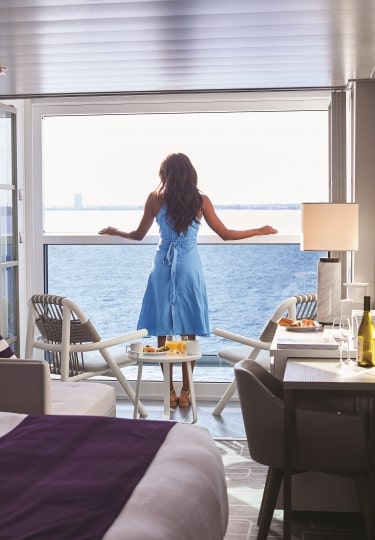
- Find a Cruise
If the only thing standing between you and an unforgettable cruise vacation on one of Celebrity Cruises’ luxury ships is worrying about whether or not you’ll get seasick on a cruise, these tips about dealing with motion sickness will ease your mind and body so you can happily book your cruise.
What causes seasickness?

Seasickness is a form of motion sickness that results when what your eye sees is out of balance with what your inner ear senses. If your body feels motion but your eye doesn’t see it, your senses become confused and can cause symptoms like dizziness, nausea, headaches, and tiredness.
Motion sickness can happen in almost any mode of travel, such as cars, trains, or even on a roller coaster.
How long does seasickness last on a cruise?
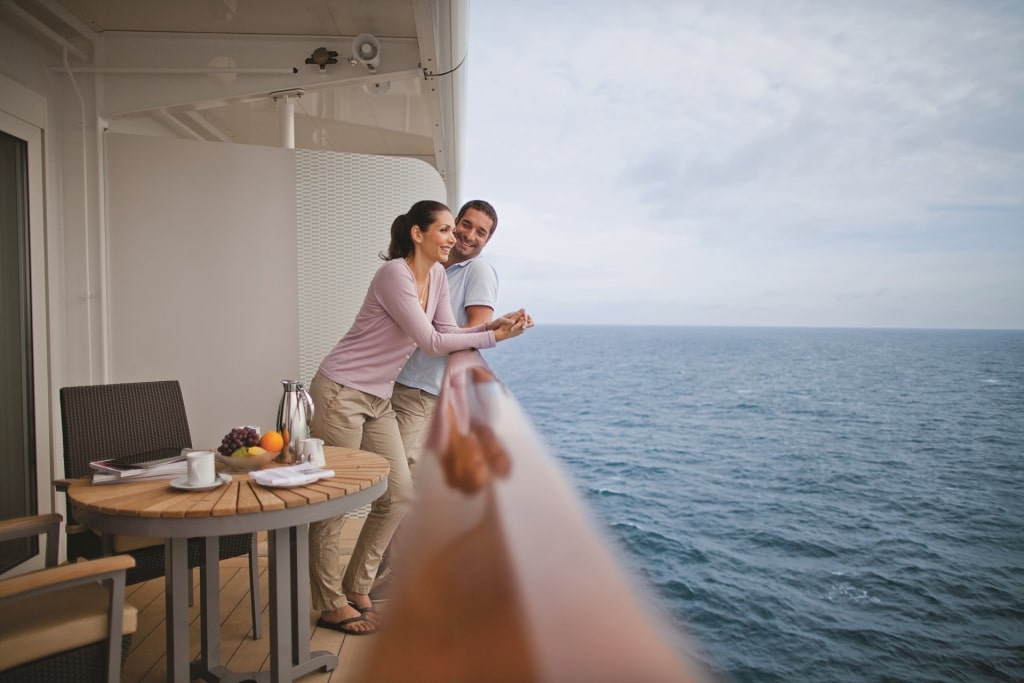
If you feel seasick at the start of a cruise, the good news is that for the great majority of passengers, seasickness usually subsides once you get your “sea legs,” which means your senses adjust and your equilibrium returns.
For most passengers who feel seasick at the start of a cruise, taking over-the-counter remedies and using the techniques recommended in this article will help you feel better in a few hours to a day or two. In some cases, particularly in rougher sea weather, seasickness may last longer.
Can you feel the ship move on a cruise?

Celebrity Cruises’ fleet of innovative cruise ships are so well designed and engineered that most of the time you won’t even feel the ship moving. Each ship is designed to give you as smooth a ride as possible without compromising the multiple activities available onboard and the spectacular on-deck views.
Our ships have stabilizers to keep the boat from rocking. Even a tilting of 1% is considered unacceptable, and Celebrity Cruises uses advanced technology to make sure your ship stays stable and calm.
What kind of cruise ships are best to avoid seasickness?
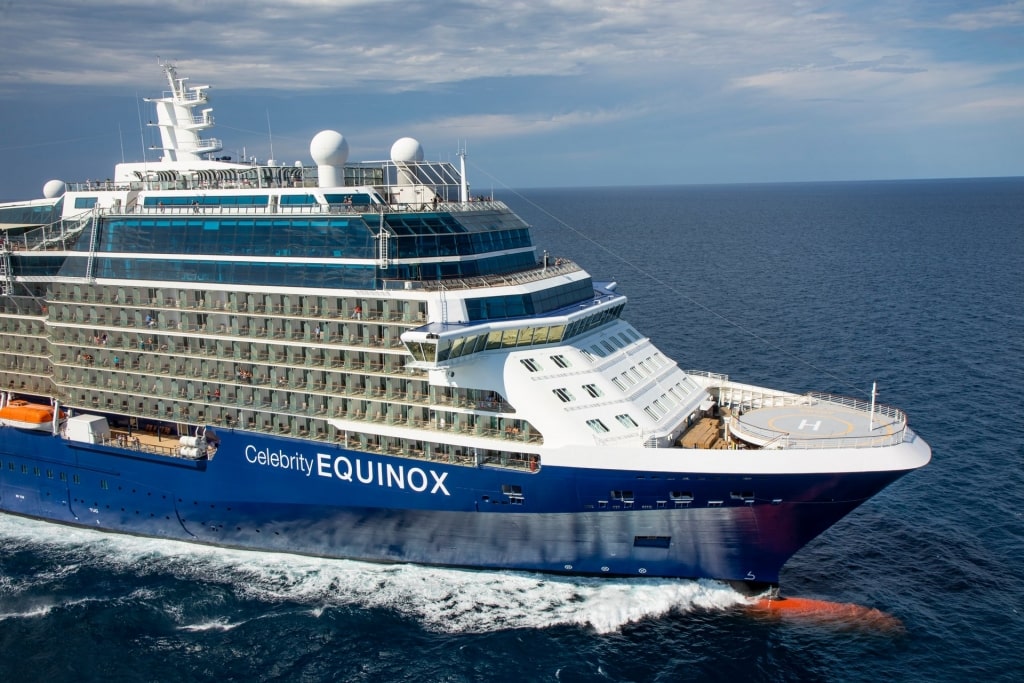
If you’re concerned about being seasick on a cruise, it’s good to know that Celebrity’s Solstice-class ships , which include Celebrity Solstice, Celebrity Silhouette, Celebrity Equinox, Celebrity Eclipse, and Celebrity Reflection, are built for smooth sailing, with fin-like stabilizers mounted beneath the ship’s waterline to ensure smooth sailing.
To give you an idea of the size and heft of these ships, each is built in post-Panamax dimensions, meaning they are too large to sail through the locks of the Panama Canal. At 122,000 to 126,000 tonnes, they glide through the water at a comfortable average speed of 24 knots, or about 27 miles per hour. They are steel-hull constructed and built with the safety and comfort of passengers in mind.
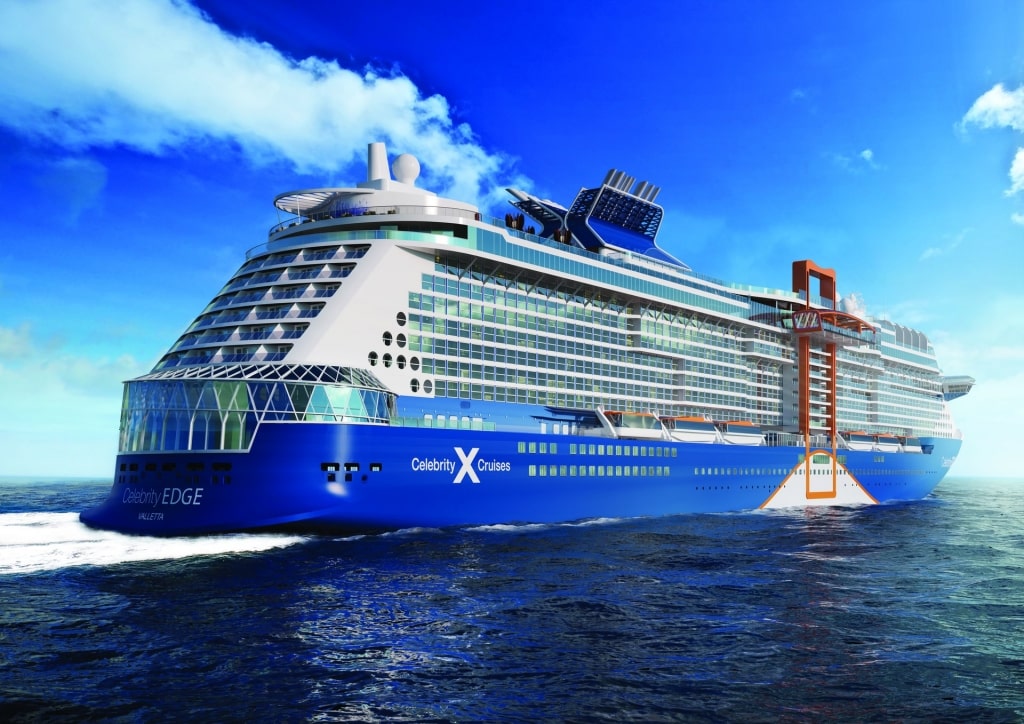
Celebrity’s newest class of ships, the Edge class, which includes Celebrity Edge and sister ship, Celebrity Apex , are the largest ships in our fleet. At 129,500 tonnes and reaching average cruising speeds of 22 knots, or about 25 miles per hour, they, too, are steel-hull constructed with stabilizers to ensure the safety and comfort of the passengers they carry.
Where is the best place to sail to avoid getting seasick on a cruise?

If you know you’re especially susceptible to seasickness, avoid itineraries that spend a lot of time sailing in open water. Cruise itineraries that stay within a sea, such as European cruises that sail along the Mediterranean Sea or Caribbean cruises that depart from San Juan, Puerto Rico are often good bets for having relatively calm waters during cruises.
One way to test the waters if you’re concerned about getting seasick on a cruise is to book a short cruise on a large ship that sails in calm water. We offer 2-night cruises from Florida to the Bahamas on our Millennium-class ship, Celebrity Infinity, and our newly revolutionized Solstice-class ship, Celebrity Equinox.

You’ll have one day at sea in each direction in the usually calm waters between Fort Lauderdale or Miami and the Bahamas. When in port, you’ll have a day to relax and play in the warm sunshine, clear blue water, and white-sand beaches of Nassau .
Another way to minimize your chances of becoming seasick on a cruise is to book a cruise that sails on one of our largest ships, like Celebrity Edge or Celebrity Apex, with 10- or 11-night itineraries that sail within the generally calm waters of the Mediterranean Sea.

Cruise from Rome on a 10-night itinerary visiting some of the most beautiful destinations in the Mediterranean, like Sicily, Naples, and the gorgeous Greek Islands. Or, sail an 11-night itinerary departing from Rome to Naples and Messina, Corfu, Greece, and up the Dalmatian Coast to Dubrovnik and Split, Croatia, and Trieste in Northern Italy.
On each of these sailings, you’ll only have two nights at sea, with the remaining time spent in port enjoying the glorious sights and pleasure of the Mediterranean.
When choosing an itinerary to avoid seasickness, consider the time of year as well. For instance, the best time to cruise the Caribbean is outside the hurricane season—the months of June through November—as they can increase the wave height and the ship movement you might feel while at sea.
Read: Cruising During Hurricane Season
What’s the best stateroom location to avoid motion sickness on a cruise?
To reduce motion sickness, choose a stateroom in the middle of the ship on a lower deck. You will feel any sway of the ship less in this section.
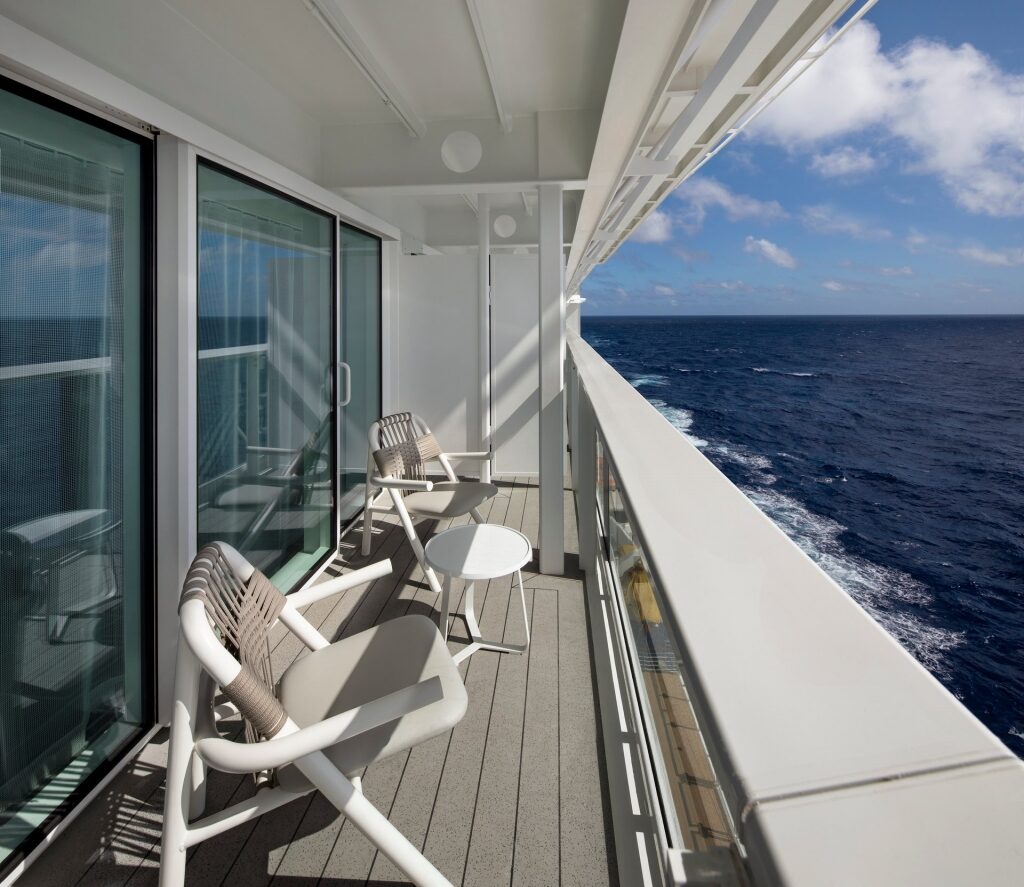
Although it may seem counterintuitive, if you’re worried about seasickness on a cruise, book a stateroom with a window or a veranda. Fresh air access and a horizon view will help alleviate seasickness symptoms.
If lower levels are already booked or you’d like to be on a higher deck for an elevated view or to be closer to the activities on the top decks, book a stateroom in the middle of the ship and avoid staterooms near the front or back (bow or aft) of the ship.
The ships’ deck plans will help you pinpoint the best stateroom location for your needs.
Read: Cruising While Pregnant
What remedies are available to alleviate seasickness on a cruise?
One way to avoid seasickness on a cruise is to get enough rest. Lack of sleep and exhaustion can make you more susceptible to motion sickness.
Motion sickness medication and natural remedies
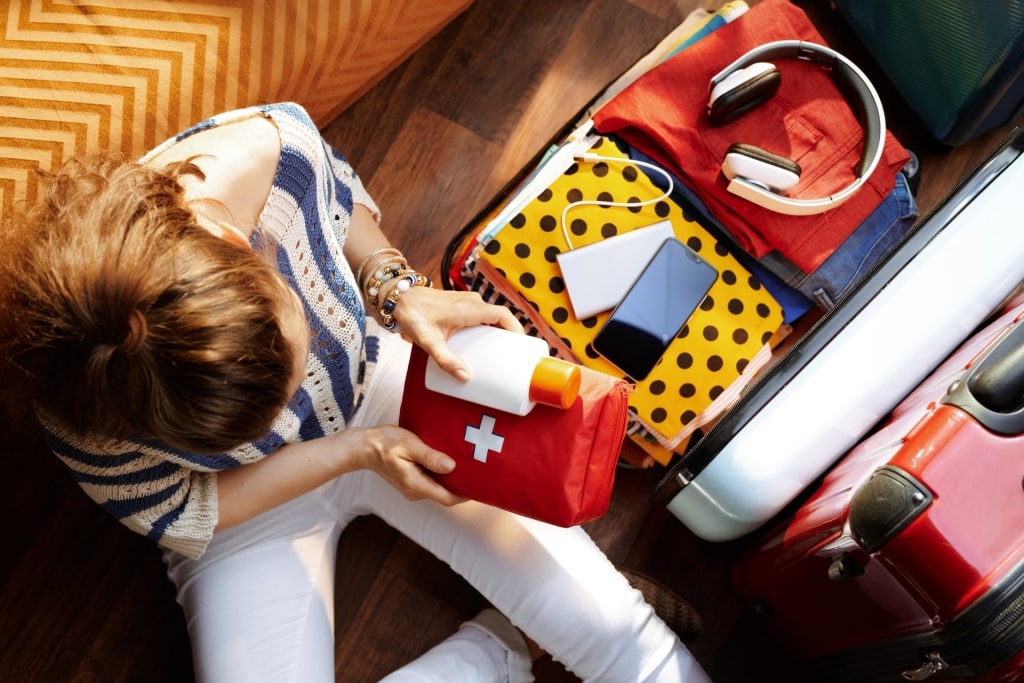
If you think you might experience motion sickness on a cruise, it’s best to be prepared. There are several over-the-counter, natural, and doctor-prescribed remedies that can help. Be sure to pack whatever seasickness remedy you choose in your carry-on bag, and take as directed, which may mean a few hours prior to boarding your ship.
If you have a doctor-prescribed transdermal patch (scopolamine), apply it as directed at least four hours before boarding your ship. The patch is active for three days, so if you’re traveling on a longer cruise, you should pack replacements.
Don’t panic if you forget to pack motion sickness medication. At the guest relations desk onboard, you’ll find tablets that will help combat seasickness.

There are also some tried and true natural remedies to alleviate the symptoms of seasickness. Ginger, whether in pill form or as a candy, is easy to keep handy as you cruise. Sucking on peppermint candy or smelling peppermint oil is also helpful.
Acupressure & acupuncture
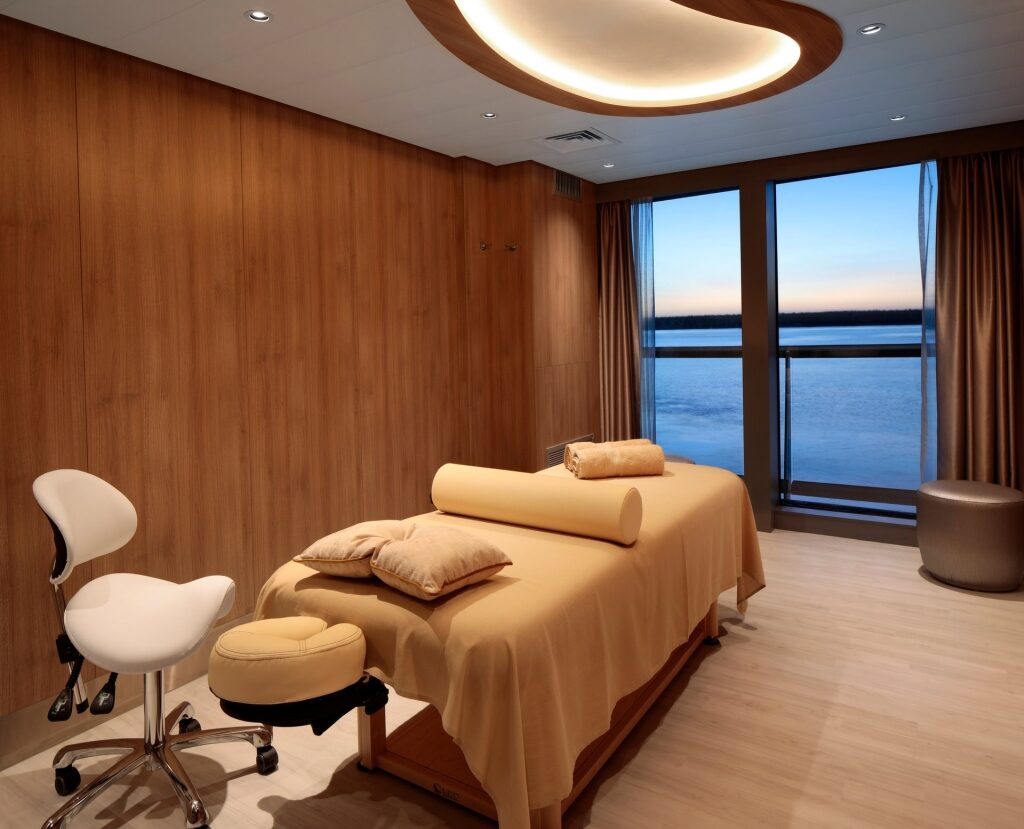
Wearing an acupressure band around your wrist is another natural way to alleviate sea sickness. If you want to take pressure-point therapy one step further, forego the band and seek out an acupuncture specialist. Our onboard spas have acupuncture technicians who will help you relieve your motion sickness.
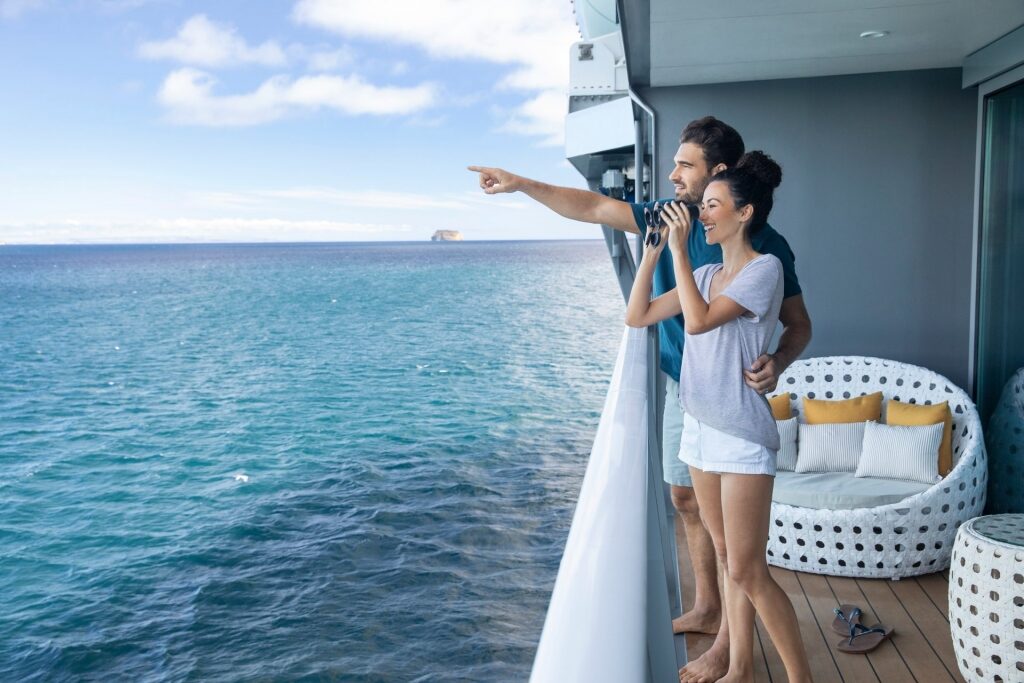
Though being seasick on a cruise may make you want to curl up in your stateroom and stay there, you’ll be amazed at how dramatically better you’ll feel if you get out and breathe in some fresh air. At the very least, step out on your veranda, take a breath of fresh air, find a spot on the horizon, and keep your eyes on it.
Make an effort to get up to the top deck and do the same. Breathing in fresh air while keeping your eyes on the horizon helps your mind and body get back in sync and may alleviate your symptoms.
What should I eat and drink to avoid motion sickness on a cruise ship?
It may sound like the last thing you want to do, but keeping your stomach full by eating small meals and snacks throughout the day can help ward off nausea from seasickness. At the very least, regularly sipping ginger ale and eating crackers may do the trick for the first 24 hours.
If you’re prone to seasickness, be cautious of your alcohol intake as alcohol can increase dehydration and exacerbate the effects of motion sickness.
Staying hydrated during your cruise is vital, as dehydration can make you feel more seasick. Our Zero Proof drink package includes unlimited bottles of sparkling and still water, such as San Pellegrino, Acqua Panna, and Evian.
Now that you know how to combat seasickness, browse our cruise itineraries , view cruise accommodations, fights, and activities all in one place or speak to one of our cruise vacation specialists at 1-800-852-8086.
Related Itineraries
Key West & Bahamas
- 3 nights ON CELEBRITY REFLECTION
- DEPARTING FROM FORT LAUDERDALE, FLORIDA
- Starting from $480 USD
Bahamas & Perfect Day
- Starting from $549 USD
- 4 nights ON CELEBRITY REFLECTION
- Starting from $609 USD
Western Caribbean & Perfect Day
- 6 nights ON CELEBRITY BEYOND
- Starting from $899 USD
- Starting from $1152 USD
Aruba, Bonaire & Curacao
- 8 nights ON CELEBRITY BEYOND
- Starting from $1759 USD
Related Articles
The Complete Guide to Dining Options on Celebrity Cruises
17 Cruise Tips for First-Timers
Accessible Travel Guide
12 Wildlife Photography Tips for Beginners
Cruises for Seniors With Disabilities: Everything You Need to Know
The Complete Guide to Taking a Cruise With a Toddler
Cruise Ship Spas: Everything You Need to Know
What Deck Is Best on a Cruise Ship?
What to Wear on a Cruise: The Ultimate Guide
The Only Cruise Packing List You’ll Ever Need
How to Take an Anniversary Cruise You’ll Cherish Forever
Top Cultural Cruise Experiences
Free Vacation Planning Services

CALL US 888-751-7804
Sign Up for Special Offers
I would like to receive electronic Promotional messages from Celebrity Cruises Inc. You can unsubscribe at anytime. Please view our Privacy Policy .
- First Name *
- Last Name *
- Email Address *
- Country * Country Afghanistan Albania Algeria American Samoa Andorra Angola Antigua and Barbuda Argentina Armenia Australia Austria Azerbaijan Bahamas Bahrain Bangladesh Barbados Belarus Belgium Belize Benin Bermuda Bhutan Bolivia Bosnia and Herzegovina Botswana Brazil Brunei Bulgaria Burkina Faso Burundi Cambodia Cameroon Canada Cape Verde Cayman Islands Central African Republic Chad Chile China Colombia Comoros Congo, Democratic Republic of the Congo, Republic of the Costa Rica Côte d'Ivoire Croatia Cuba Curaçao Cyprus Czech Republic Denmark Djibouti Dominica Dominican Republic East Timor Ecuador Egypt El Salvador Equatorial Guinea Eritrea Estonia Ethiopia Faroe Islands Fiji Finland France French Polynesia Gabon Gambia Georgia Germany Ghana Greece Greenland Grenada Guam Guatemala Guinea Guinea-Bissau Guyana Haiti Honduras Hong Kong Hungary Iceland India Indonesia Iran Iraq Ireland Israel Italy Jamaica Japan Jordan Kazakhstan Kenya Kiribati North Korea South Korea Kosovo Kuwait Kyrgyzstan Laos Latvia Lebanon Lesotho Liberia Libya Liechtenstein Lithuania Luxembourg Macedonia Madagascar Malawi Malaysia Maldives Mali Malta Marshall Islands Mauritania Mauritius Mexico Micronesia Moldova Monaco Mongolia Montenegro Morocco Mozambique Myanmar Namibia Nauru Nepal Netherlands New Zealand Nicaragua Niger Nigeria Northern Mariana Islands Norway Oman Pakistan Palau Palestine, State of Panama Papua New Guinea Paraguay Peru Philippines Poland Portugal Puerto Rico Qatar Romania Russia Rwanda Saint Kitts and Nevis Saint Lucia Saint Vincent and the Grenadines Samoa San Marino Sao Tome and Principe Saudi Arabia Senegal Serbia Seychelles Sierra Leone Singapore Sint Maarten Slovakia Slovenia Solomon Islands Somalia South Africa Spain Sri Lanka Sudan Sudan, South Suriname Swaziland Sweden Switzerland Syria Taiwan Tajikistan Tanzania Thailand Togo Tonga Trinidad and Tobago Tunisia Turkey Turkmenistan Tuvalu Uganda Ukraine United Arab Emirates United Kingdom United States Uruguay Uzbekistan Vanuatu Vatican City Venezuela Vietnam Virgin Islands, British Virgin Islands, U.S. Yemen Zambia Zimbabwe

STAY IN THE KNOW
Thank you for subscribing.
See you on board soon.
Do you really need a motion sickness patch for your cruise?

You've boarded your first cruise and spy lots of your shipmates sporting a patch behind their ears. Why are they wearing this? Does it improve their cruise experience? What do all those people know that you don't?
Those little circular patches you see behind the ears of so many cruisers are most likely a prescription drug called scopolamine transdermal system. It is often prescribed for situational nausea and vomiting after surgery. However, it is also useful for motion sickness, as you might experience on board cruise ships. The medication contained in the patch is slowly released into the wearer's system over the course of three days. It works through the central nervous system to calm the digestive system.
Now that you know, you might develop a case of FOMO. Should you have asked your doctor for patches for your cruise? When I mentioned the patches to my primary care physician (a fellow cruiser), her response was quick and a bit snarky, "What is up with everybody thinking they need scopolamine patches to go on a cruise?"
She explained that she sees many people with no history of motion sickness who want them. However, she cautions they aren't for everyone.
For cruise news, reviews and tips, sign up for TPG's cruise newsletter .
After talking with my doctor, I did further research on prescription motion sickness patches for cruising. Here's what I learned about whether you really need that scopolamine patch — or if you're better off without it.
You might not need a patch to weather your cruise
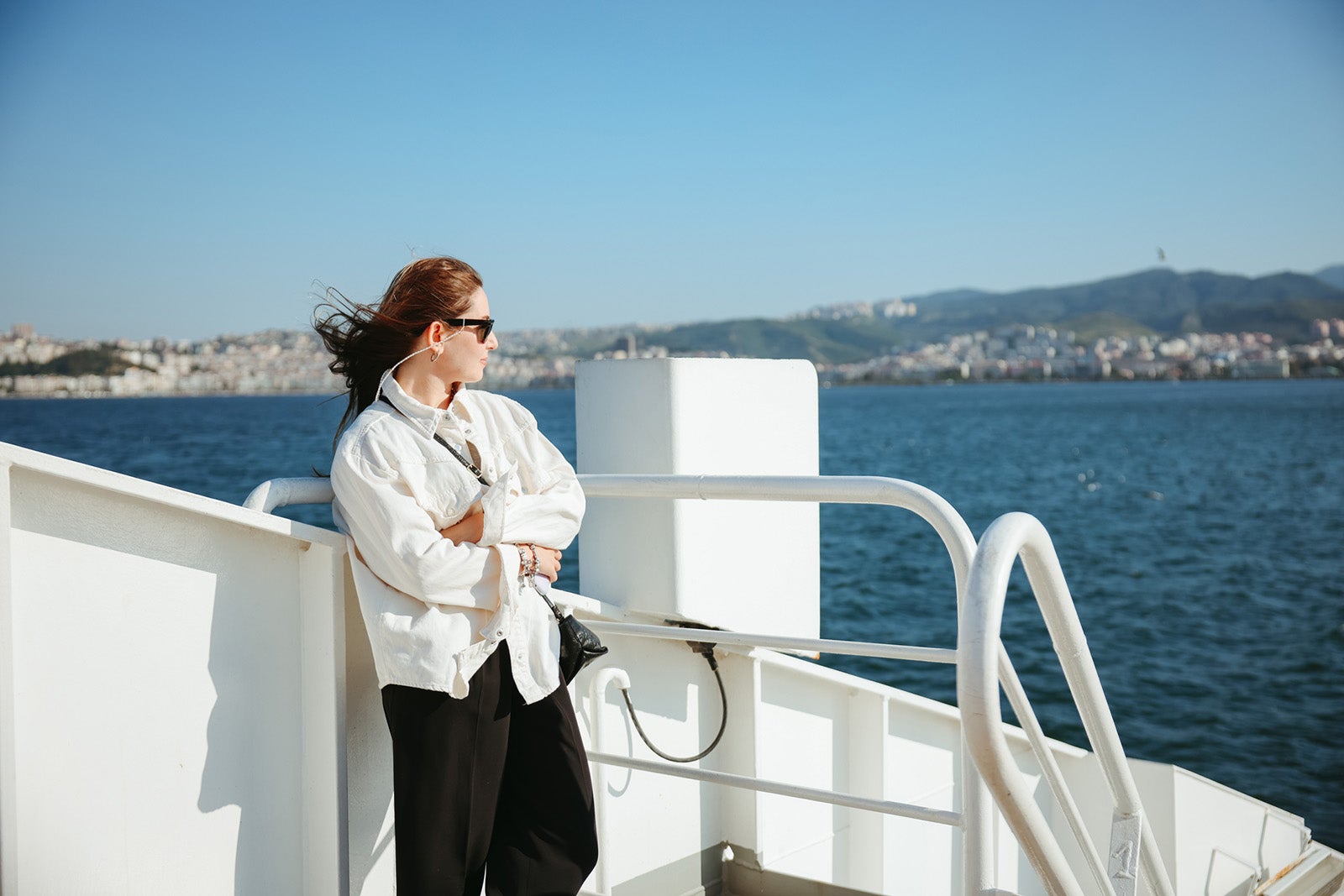
Motion sickness is a possibility on a cruise ship, but don't assume you will experience it on your sailing. Most large ships are stabilized to prevent excessive motion, and the average cruise (especially to popular destinations in the Bahamas and the Caribbean) takes place in calm waters.
Also, some people are more prone to seasickness than others. If you frequently ride roller coasters and don't have trouble on airplanes no matter how turbulent, or if you can sit in the backseat of a car on a winding mountain road, you probably aren't prone to feeling nauseated from movement.
For many people who do feel ill on a cruise, motion sickness is a limited-time event. It might hit you during the first 24 hours of sailing, quickly calming down as your nervous system adapts to the motion. Symptoms might only affect you when the exact set of circumstances appears that disturbs your equilibrium enough to cause nausea. They may then disappear as soon as the ship rights itself, so to speak, or when you head to the more stable lower decks and gaze out at the horizon.
In this case, too, wearing a patch for the duration of the cruise is not warranted.
Still, there are some people who will become ill just reading about rocking ships or turbulent flights and are extremely nervous about heading out to sea on a boat. If that's you, patches for the duration of any cruise are something you might consider.
Related: How to avoid seasickness on your next cruise

Not everyone can use scopolamine patches
The active medication in the patches can interact with some other medications. It's a long list and includes common over-the-counter medications like Benadryl. You, your doctor and your pharmacist should carefully evaluate your potential for medication conflicts if you plan to use motion sickness patches during your cruise.
Also, patches aren't the only seasickness remedy you can try. Some people use over-the-counter medication tablets, such as Dramamine or Bonine. You can also try alternatives to medicine like acupressure bands for your wrists or settle your stomach with foods such as green apples, ginger ale or ginger candies, and crackers.
Related: How to avoid getting sick on a cruise
The patches can have surprising side effects
A motion-sickness patch may look innocuous. However, it is still a prescription medication and can have adverse side effects not to be taken lightly. Consider the possibility of ill effects before you commit to the patch on your next cruise.
For example, I met a woman who put on a patch during her first cruise. She discovered several hours later, as she was putting makeup on that the pupil in one of her eyes was fully dilated — the eye on the side where her patch was placed. She thought she was having a stroke. She contacted her physician, who advised her to immediately remove the patch. The dilation subsided, and all was well for the remainder of her cruise.
She had not experienced any seasickness before using the patch nor after removing it. She had simply taken a proactive approach, just in case. Her medical chart now includes her reaction with a note that she cannot use scopolamine. She does, however, intend to cruise again and hopes her lack of motion sickness on her first cruise will hold true in the future.
Other side effects of the patches include dry mouth, dizziness, drowsiness and even disorientation. Also, a big problem for many cruisers is that you should not consume alcohol while wearing the patch. Doing so intensifies the side effects, especially drowsiness and dizziness.
Related: Do cruise ships have doctors, nurses, medical centers or hospitals?
Patches can be useful in rough seas
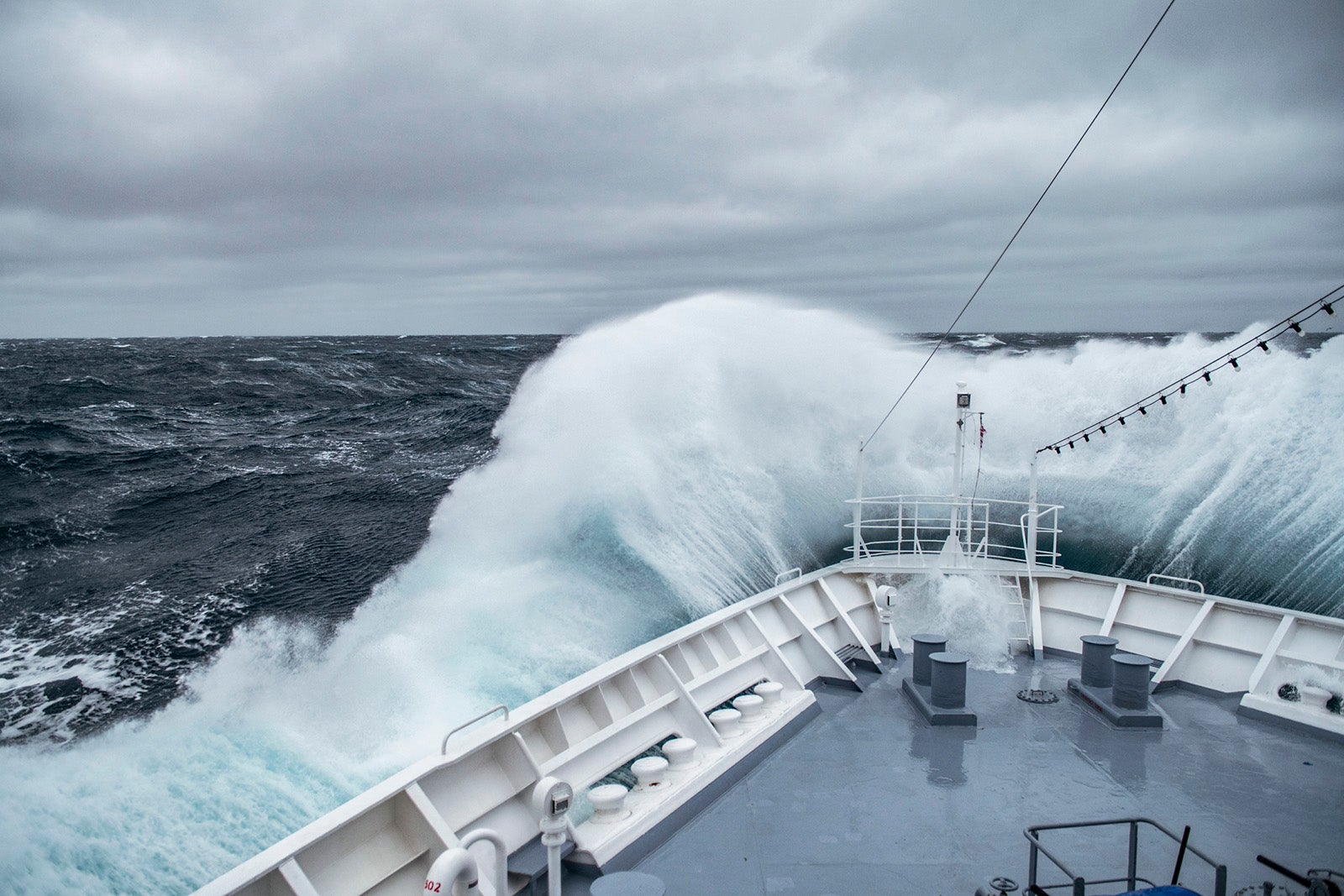
Although ship captains aim to avoid dangerously rough seas, cruise ships are designed to handle far larger waves than one might think. That means choppy rides may occur. You'll know rough seas are ahead when you see motion-sickness bags strategically placed in the stairwells.
Scopolamine patches can be useful on any cruise with the potential for large waves, such as hurricane season sailings, transatlantic crossings and cruises through notoriously rough waters, such as the Drake Passage on the way to Antarctica. If you're nervous about feeling ill during any of these sailings, that is the perfect time to talk to your doctor about a prescription for patches.
Related: What to do if you find yourself on a wildly tilting cruise ship
If you are prone to motion sickness in general, talk to your doctor about prescription patches. My physician said she wouldn't have a problem prescribing the patches for someone going on their first cruise if they don't have conflicting medications or conditions and understand that there are side effects.
There are a few itineraries and seasons for which even the most sea-hardy among us might proactively take along a supply of patches. It's better to be prepared and not need them than to suffer through a rough ride without any relief.
If you have successfully worn scopolamine patches in the past without side effects, consider only wearing one the first 24 hours of the cruise or when rough seas are expected.
Bottom line
If you've never cruised but generally don't experience motion sickness, don't assume you'll need seasickness medication for your first sailing. You might be surprised that a cruise ship's ride is much smoother than you thought.
However, if you're worried motion-induced nausea may sideline you during your cruise, talk to your doctor about the best motion sickness medications before you sail.
Planning a cruise? Start with these stories:
- The 5 most desirable cabin locations on any cruise ship
- A beginners guide to picking a cruise line
- The 8 worst cabin locations on any cruise ship
- The ultimate guide to what to pack for a cruise
- A quick guide to the most popular cruise lines
- 21 tips and tricks that will make your cruise go smoothly
- 15 ways cruisers waste money
- The ultimate guide to choosing a cruise ship cabin

- Food & Drink
- How to Plan
- Shore Excursions
- Onboard Activities
- What to Expect
How to Avoid Getting Seasick on a Cruise
By Carnival Cruise Line
Pack Your Medicine
- Get a Good Night’s Sleep
Remember to Eat
Get Some Air
Watch the Horizon
Avoid Books and Screens
Head to the Middle
Try Acupressure
Look Into Alternative Medicine
There is little better in life than sitting back and enjoying a cruise on the open sea. From the fun onboard activities to the amazing exotic locations, there’s a lot to love about traveling with Carnival cruises . However, the last thing you want is for your wonderful trip to be ruined by something you can’t control. If you are inclined to motion sickness but want to ensure an enjoyable cruise, take the following steps to avoid seasickness.
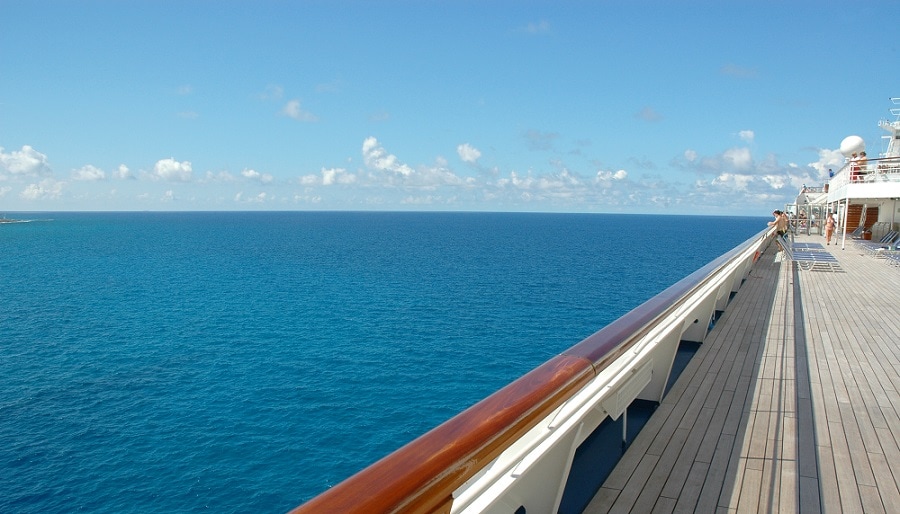
If you know the rocking of the waves might upset your stomach, plan ahead by packing some medication for seasickness. Antiemetic drugs, or medicine that keeps one from feeling nauseous, are readily available over the counter in drug stores nationwide. Your doctor can prescribe stronger scopolamine medicine in patch or pill form as needed. Either way, be sure you remember to pack these medications to keep you from feeling sick as you cruise to your destination.
Get a Good Night’s Sleep
You might find it difficult to rest the night before your cruise – who wouldn’t be excited before a trip like this? However, exhaustion can exacerbate the effects of motion sickness and make you more susceptible to feeling ill. Be sure to get a good night’s sleep before setting sail, so your body is rested and ready to fight seasickness if it rears its ugly head.

It may feel counter-intuitive, but traveling on an empty stomach is more likely to make you feel ill than traveling after a light meal. To help settle your stomach, have a simple snack about one hour before you depart, and remember to continue snacking every few hours throughout the cruise. However, avoid fatty, acidic or spicy foods to keep from getting nauseated. You may want to avoid alcohol if you feel like you may become ill, since the dehydration it causes can lower your resistance to sickness.

If you start to feel the telltale signs of nausea, head out onto the deck for some fresh air. This change of environment will alleviate the rise in your body temperature (save that for a day on the beach in the Caribbean ), and the wind in your face will help reduce uncomfortable sweating. While there, focus on your breath to bring yourself back down to a calm and relaxed state.
Most seasickness is attributed to a disconnect between your senses and your physical movement. Watching the water speed past can be disorienting, and trying to keep your balance as the ship moves might only result in motion sickness. However, mariners have been advising this tip forever: simply look out at the horizon – a stable focal point – to reorient yourself. This will help to reset your equilibrium. To make your life a bit easier, request a room with a window so you can keep your eyes on the prize whenever you need to!
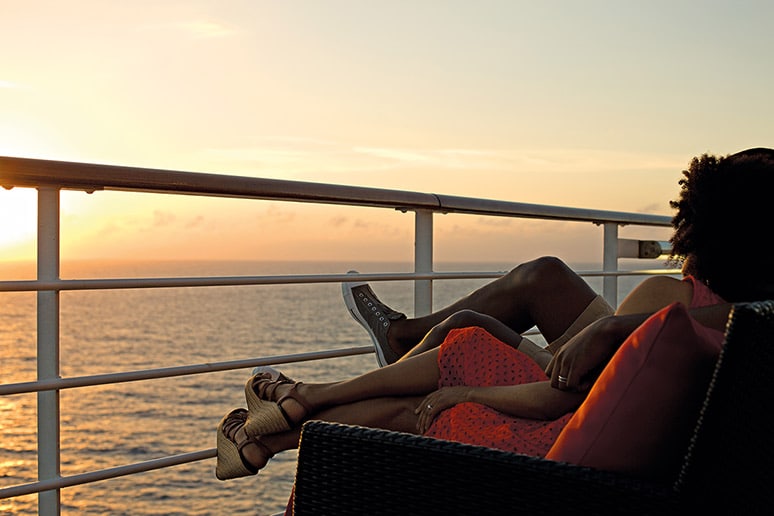
While kicking back with a novel or laptop on the way to The Bahamas may sound like a dream, there’s also a good chance it will trigger motion sickness. Watching a stationary object like a book can convince your middle ear it’s wrong, making you feel nauseated. Instead, focus on the horizon or rest with your eyes closed to avoid confusing your body.
The swaying and seesawing of the boat will be most extreme on the outside edges, so head to the middle of the ship to alleviate some of the effect. You may even want to book a room in this area of the cruise ship so your nights are less rocked by the motion of the ocean.
Another popular method for decreasing seasickness is through wearing a wristband that will apply pressure to a spot on your wrist. Whether real or placebo, many people swear by this trick. If you don’t have a wristband on you – or you left it at home when you set sail for Mexico – you can try pressing your wrist with your opposite thumb for relief.
Looking for something to try before you travel to your destination ? Some studies have shown a correlation between getting proactive acupuncture treatment and minimized seasickness. This method focuses on the same area as acupressure wristbands, but it could be useful if you want to try preventing seasickness before you even set sail.
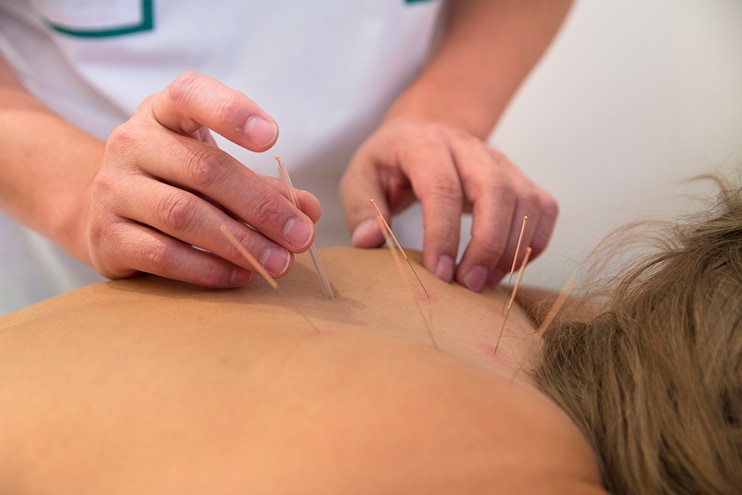
If you aren’t keen on taking pills, rest assured there are plenty of ways to combat seasickness using natural substances. Chewing on ginger or sipping ginger ale is a common approach, but you could also try some classic aromatherapy. Scents like peppermint and lavender can calm your senses and encourage important deep breathing when feeling nauseated.
Of course, if you still find yourself feeling seasick, know that Carnival is happy to get you back on your feet. Head to the Medical Center or call room service for motion sickness pills that will help you feel healthier and ready to greet the day again.
Note: Onboard activities, shore excursions, and dining options may vary by ship and destination.
Related articles
Plan for fun.
https://www.carnival.com/cruise-from.aspx

- Cruise Advice
Seasickness on a Cruise: 7 Tips to Avoid It

Doug Parker
- June 23, 2023
Those that struggle with motion or seasickness don’t have to stop going on cruises! With our 7 helpful tips you’ll get to enjoy a weekend out at sea all you want.

Before we get into it, let’s start by defining the term motion sickness – just what causes it?
Seasickness happens when your brain gets conflicting messages from your inner ears, eyes, and sensory nerves. Your inner ears help with balance by detecting motion while your eyes don’t see that movement. It’s that inconsistency that confuses and agitates your brain.
And while some people are more prone to seasickness than others, it’s still something that could ruin your boat trip. So, check out how you can stop that from happening.
1. Choose the Right Cabin
Picking the right cabin to stay at goes a long way in balancing out your seasickness. We’ve found that the best cabins to book from are those present on the middle or lower deck.
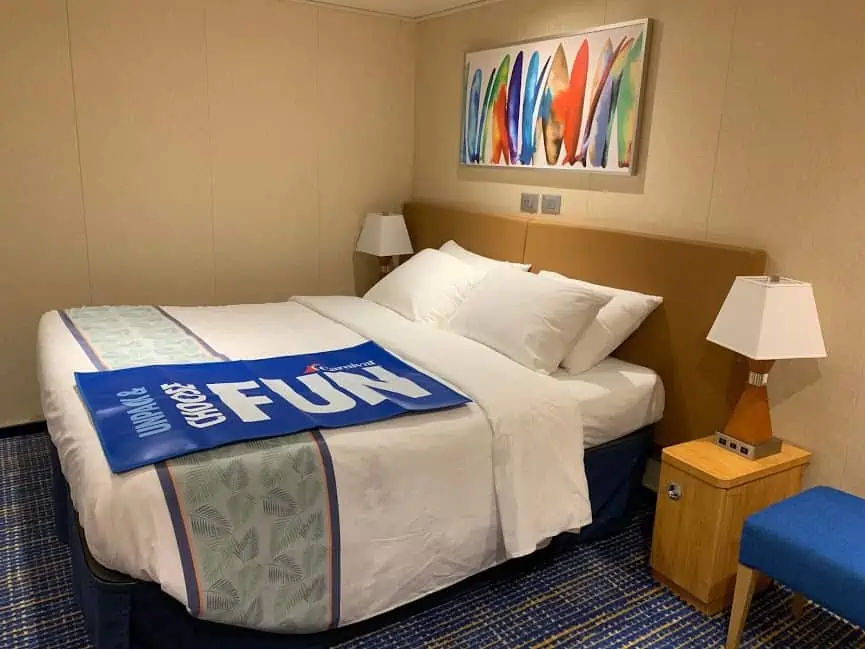
Mid-Ship Cabins
Book a mid-ship cabin to experience the least amount of motion on board. Cabins near the front or back of the ship are more prone to movement, making it harder for travellers prone to seasickness.
So, to avoid this, consider the mid-ship cabins, which provide a smoother ride since they are in the centre of gravity on board. You may also upgrade to a balcony room. Those provide both fresh air and natural light that can help reduce nausea while giving stunning sea views.
Lower Decks
Choosing a room on the lower decks can significantly reduce the rocking sensation and help prevent seasickness. If your motion sickness is particularly horrible, pick a cabin in the middle of the lower deck. Such cabins experience the least movement and are as stable as it gets.
Read more: Motion Sickness: Picking the right cabin, itinerary, and cruise ship
2. Take Motion Sickness Medication
When it comes to meds, you have the choice to pick from the following:
- OTC medication
- Prescription meds
- Acupressure wrist brands
Below, we cover each point in further detail to help you figure out the best course of action for your seasickness.
Over-the-Counter Medication
Ginger supplements are a popular natural remedy for motion sickness. They can be capsules or chewable tablets, which you can buy in most drugstores and health food stores. Ginger helps alleviate nausea and vomiting, making it a practical option for those prone to seasickness.
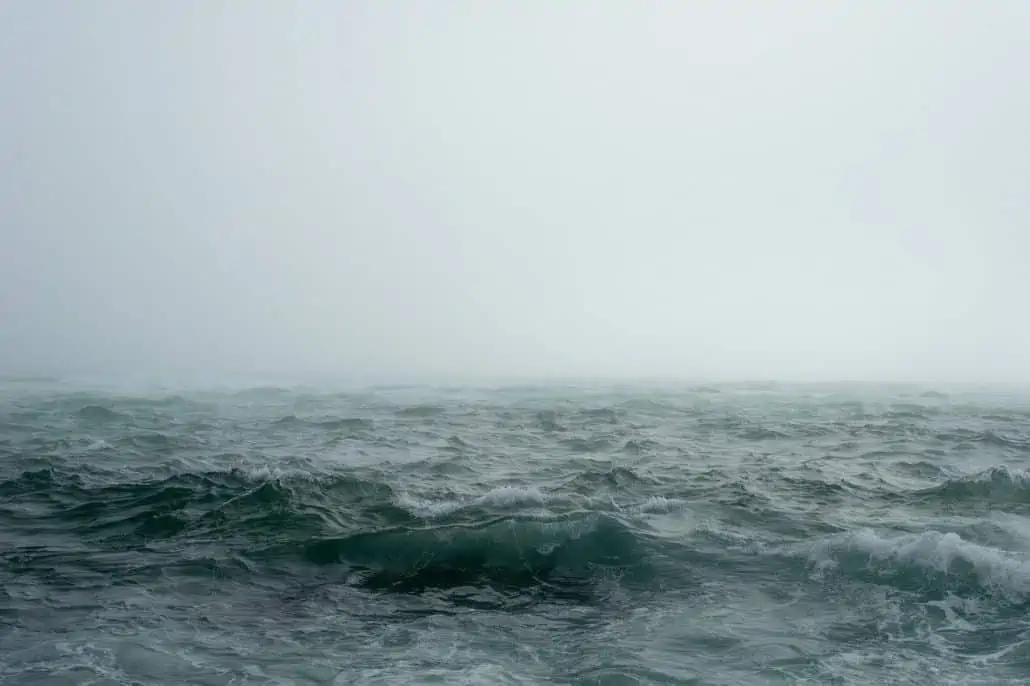
Consider antihistamines, such as Dramamine and Bonine, as well. They block messages between the inner ear and brain that cause nausea and vomiting.
They’re even considered among the best motion sickness medicine for cruises. However, they may cause drowsiness or other side effects .
So, it’s important to follow the recommended dosage instructions carefully – taking more than what’s prescribed won’t increase effectiveness and can only lead to unwanted side effects.
Bonine vs Dramamine
The formula composition of both Bonine and Dramamine is the main difference between either drug. While the two are effective in reducing your motion sickness, Dramamine can make you more drowsy than Bonine.
That’s because Dramamine contains dimenhydrinate – which while works more quickly, will cause more drowsiness. On the other hand, Bonine contains meclizine, which provides long-lasting effects and is associated with less drowsiness.
Additionally, meclizine stays in your body for up to 24 hours so you can enjoy the cruise to its fullest. Dimenhydrinate lasts in the body for no more than 4 to 6 hours, though.
When to Take Dramamine Before Cruise?
If you insist on taking Dramamine, know that the medication takes at least 30 minutes to 1 hour to kick in.
As such, it’s recommended that you take it an hour or so before boarding the ship or taking on an activity that triggers your motion sickness. Once you feel your symptoms alleviating, you can proceed to take Dramamine as directed on the packaging.
And if you were to take Dramamine after your motion sickness has taken effect, it’ll still take 30 minutes to an hour before you feel any relief.
Prescription Medication
If over-the-counter medication isn’t working for your motion sickness, then prescription medication may be the answer.

Scopolamine patches , for instance, worn behind the ear, can help prevent nausea and vomiting caused by motion sicknesses. Discuss all options with your doctor before deciding on prescription medication for seasickness relief during your cruise vacation.
Keep in mind also that seasickness medication can be pricey depending on what brand and type you go with. So before travelling, check discount vouchers at Boots and get the best travel sickness medicines.
Use Acupressure Bands
Acupressure bands are a great way to combat seasickness on a cruise ship. These bands use pressure points on the wrist to alleviate nausea and dizziness caused by motion sickness.
They stimulate the body’s natural healing processes, making them a practical, drug-free solution for seasick people.
While there is limited scientific evidence of their effectiveness, many people find them helpful as a non-invasive alternative to medication.
Look for acupressure bands at drugstores or online retailers. They fit comfortably around your wrist and have adjustable pressure settings. It’s essential to wear them before you begin feeling symptoms of seasickness though, so be sure to put them on before setting sail.
Where to Buy Acupressure Bands?
You can buy acupressure bands at Amazon or Walmart, which offer competitive pricing options, and at pharmacies, such as CVS or Walgreens. Specialty stores like REI or outdoor supply shops may also sell acupressure bands.
It’s important to note that not all acupressure bands are the same, so do your research before purchasing. Double-check reviews and ratings from customers who have used the product before.
4. Stay Hydrated
Drinking plenty of water throughout the day can help prevent dehydration, which can worsen motion sickness symptoms.
So, be sure to carry a refillable water bottle and take frequent sips—especially if you’re spending too much time in the sun or participating in activities that make you sweat.

Additionally, limit your intake of alcoholic beverages to avoid seasickness on a cruise. Alcohol can dehydrate you and amplify the effects of motion sickness, making it more likely for you to feel unwell.
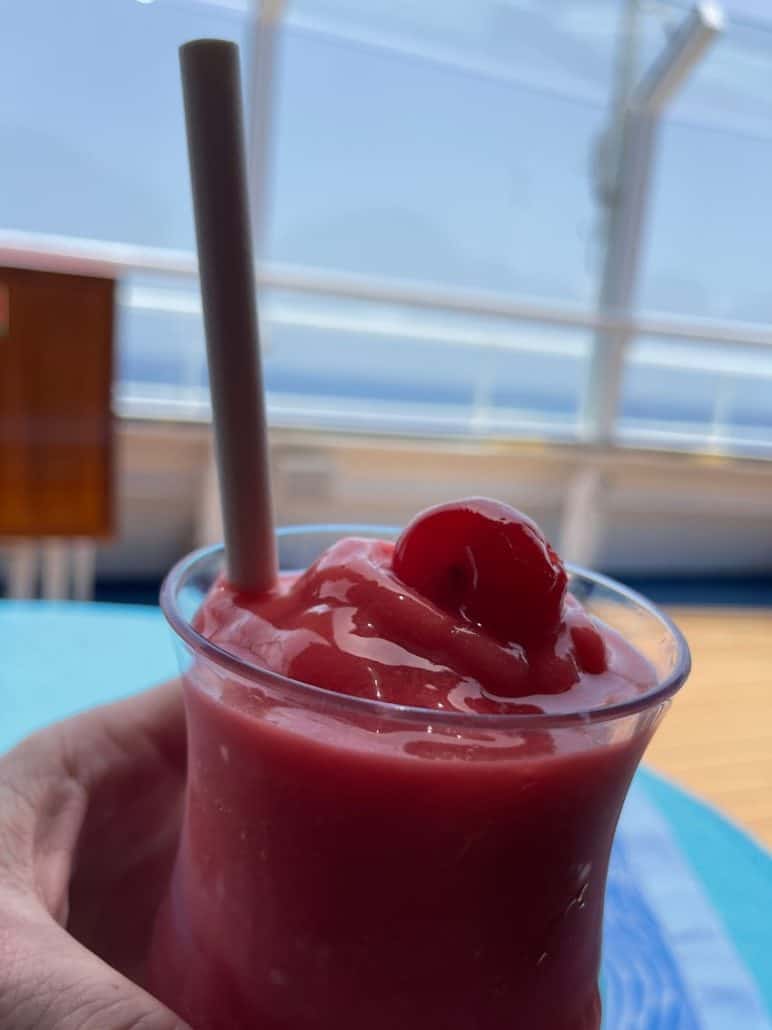
Avoid energy drinks that contain high levels of caffeine as well. These glasses can raise heart rate and blood pressure, triggering symptoms such as nausea, dizziness, etc., making it difficult to enjoy your time at sea.
Opting for plain water with electrolytes added – like coconut water – will keep your hydration balanced without causing unwanted side effects.
5. Eat the Right Food
Eating the right foods is one of the best ways to avoid seasickness on a cruise ship .
Stay clear of heavy, greasy meals that can upset your stomach and make you more susceptible to motion sickness. Instead, stick to lighter fare, like fruits, vegetables, and lean proteins.
Don’t stop there; keep eating small meals throughout the day. Doing so will help keep your blood sugar levels stable and prevent feelings of nausea or dizziness.
Consider snacking on crackers or hard ginger candy for extra stomach-soothing goodness between larger meals.
6. Get Regular Fresh Air
Take a break and head up to the deck for some fresh air. Breathing in the salty sea breeze can help alleviate seasickness symptoms and provide a calming effect.
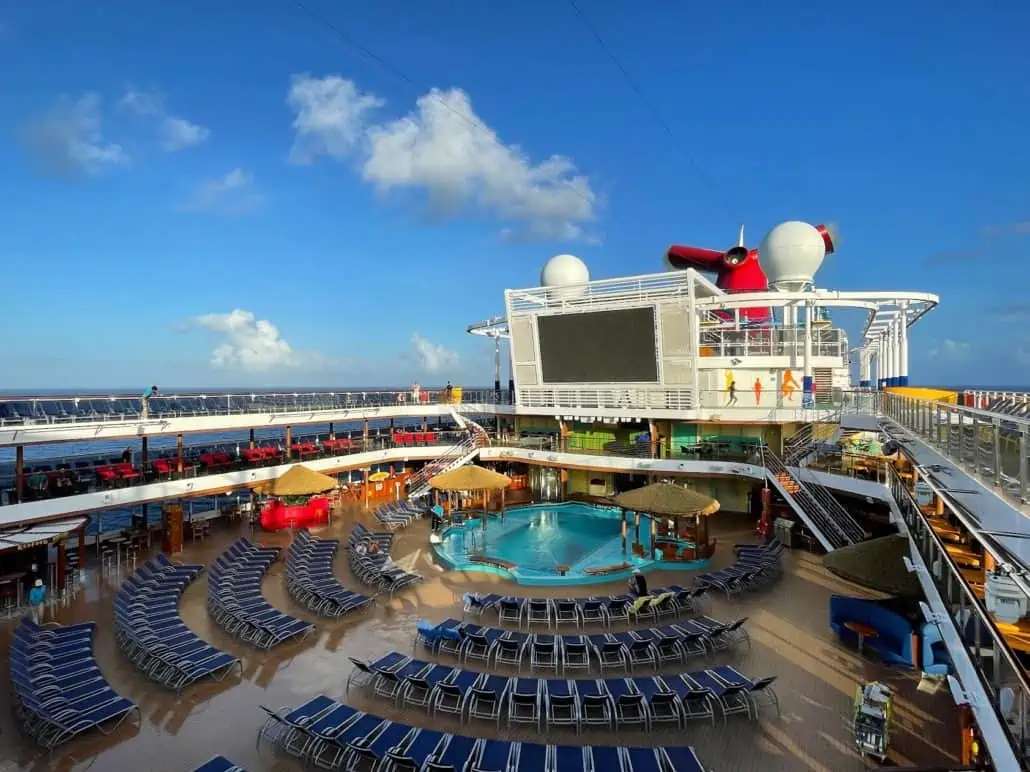
If it’s too windy, try finding a sheltered spot where you can feel the breeze without being exposed to strong gusts.
7. Consider Natural Seasickness Remedies
Remember that old saying about an apple a day can keep the doctor away? While that might not be true, eating apples can alleviate seasickness—but not just any apple, though.
Look for green Granny Smith apples; their pectin combined with natural sugars reduces acid and settles topsy-turvy stomachs.

Peppermint is also known to have the same effects against seasickness. If you’re lucky, you might find some cruise line sundry shops selling peppermint oil.
At the end of the day, cruisers have little to lose by trying out some of these natural solutions for seasickness before taking medication. Their low cost and ease of access are appealing.
Final Thoughts
Don’t let motion sickness keep you from experiencing what the cruise ships offer!
Just remember to stay hydrated, avoid heavy meals, and take preventative medication if necessary to avoid seasickness on a cruise.
The U.S. Centers for Disease Control also lists more tips and remedies to help avoid motion and seasickness .
Medical Disclaimer: This article is not a substitute for professional medical advice, diagnosis, or treatment. Always seek the advice of your physician or other qualified health providers with any questions you may have regarding a medical condition.
Pin it for later!

Recent Posts
Port canaveral announces plans for a brand new cruise terminal coming in 2026, princess relocates cruise ship from australia to puerto rico, cruise ship sails into new york with a dead whale, carnival glory review 2024 + cruise news [podcast], share this post, related posts.

Air Force Called for Long Distance Rescue on Carnival Ship [PHOTOS]
![medicine for cruise motion sickness Sea Trials Begin for Royal Caribbean’s Latest Mega Cruise Ship [PHOTOS]](https://cruiseradio.net/wp-content/uploads/2024/05/Utopia-of-the-Seas-3-300x160.jpg)
Sea Trials Begin for Royal Caribbean’s Latest Mega Cruise Ship [PHOTOS]

Bringing you 15 years of cruise industry experience. Cruise Radio prioritizes well-balanced cruise news coverage and accurate reporting, paired with ship reviews and tips.
Quick links
Cruise Radio, LLC © Copyright 2009-2024 | Website Designed By Insider Perks, Inc
The Truth About Seasickness
Our chief medical consultant gives us his best tips on preventing seasickness..

One of the most common questions first-time cruisers have is “What if I get seasick?” We understand where the concern comes from, and we have answers. We’ve enlisted Dr. Benjamin Shore, Chief Medical Consultant at Royal Caribbean, to break down the basics and whether it’s actually common for guests to experience seasickness while vacationing at sea.
“Considering the large size of today’s cruise ships , seasickness is rarely a problem,” says Dr. Benjamin Shore. He adds that with innovative design and engineering, ships can also safely navigate around inclement weather , and use stabilizers—fins built off a ship’s port and starboard sides along the water line—to reduce side-to-side motion so most guests never experience any motion sickness.
Before we get to the specifics, here are the basics: Motion sickness occurs when what you see conflicts with what your inner ear senses. In other words, if you’re sitting in a car (not moving) but your inner ear detects movement (the car just hit 70 mph on the highway), the two signals being sent to your brain don’t match. Those mixed signals confuse the brain, and the sensations and symptoms (dizziness, nausea) are the result.
In the event that seasickness does develop, Dr. Shore assures that it’s unlikely to really interrupt your adventure, since all Royal Caribbean ships have motion sickness medications, like meclizine, readily available at the dedicated Medical Center on each of our ships, free of charge.
“Additionally, for more troublesome seasickness, our Medical Centers also carry promethazine and metoclopramide,” Dr. Shore says.
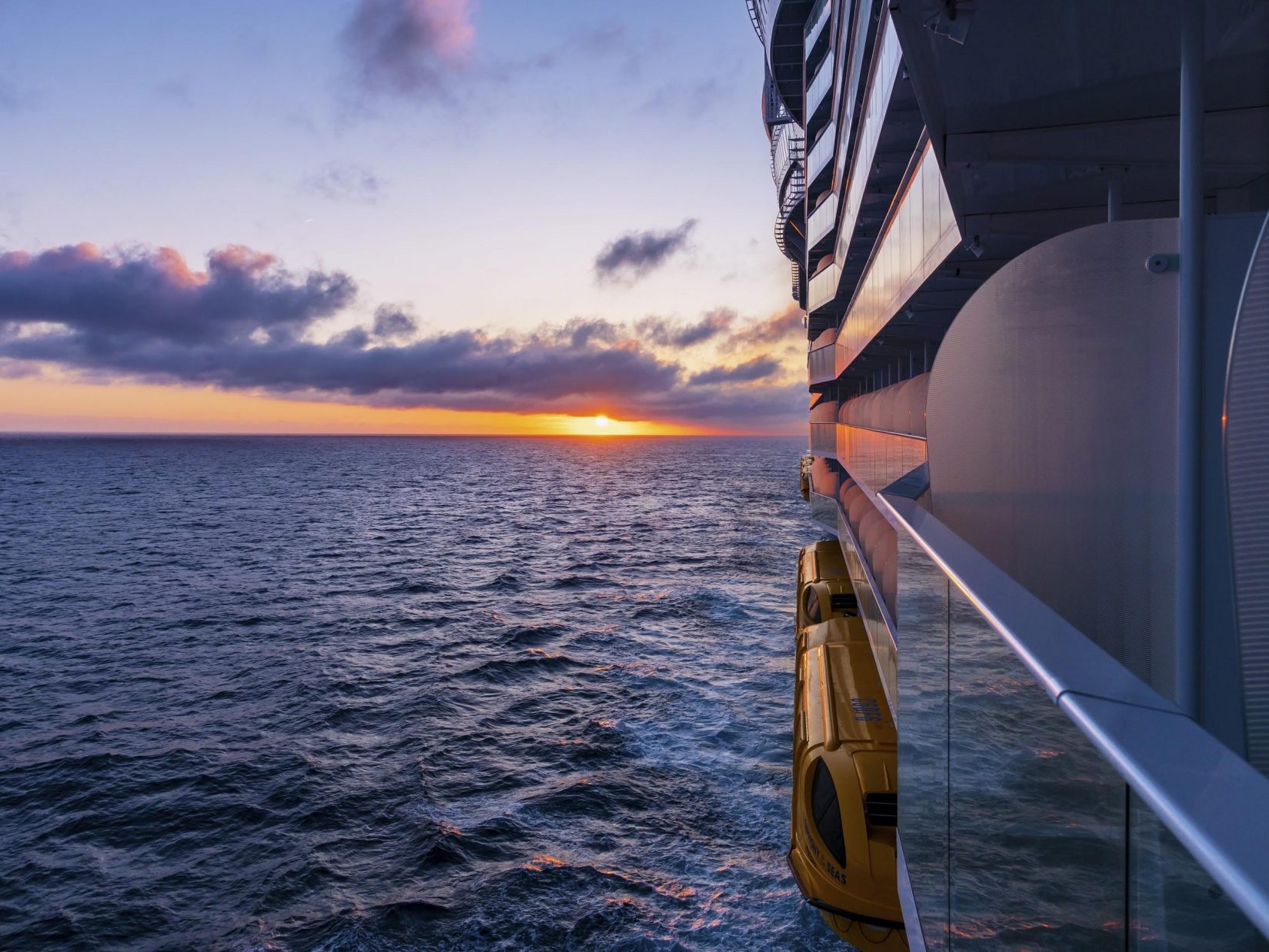
Sometimes the best treatment is prevention. “It’s best that guests who know they are prone to seasickness consult their doctor prior to departure,” Dr. Shore says. If your personal physician thinks it’s appropriate, he or she can prescribe a patch that you can wear to prevent the onset of seasickness. “For prescription patches like Transderm Scop, it’s important for it to be applied prior to boarding to be effective,” he adds.
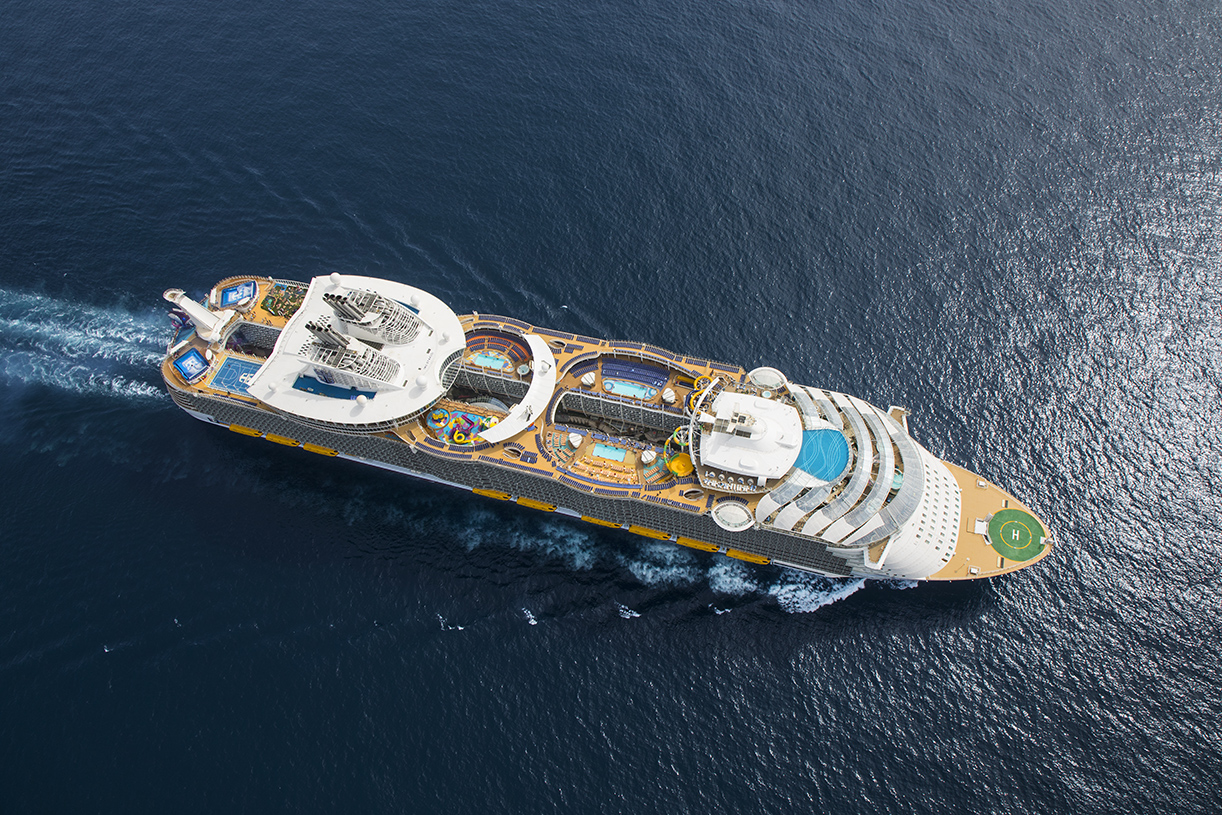
Dr. Shore notes that there are also lots of natural remedies that can help alleviate motion sickness. “Anecdotally, ginger seems to be helpful, and some people find various aromas (like anise, basil, chamomile and peppermint) or eating dry crackers, even after the onset, of seasickness can help.” If a few sips of ginger ale or chewing fresh ginger doesn’t do the trick, he also suggests going for a short walk to the center of the ship, the most balanced area on board and therefore least likely to produce seasickness symptoms.
An unexpected solution Dr. Shore suggests is “the smelling of newspaper print!” He says, “science has no idea why this works so well, but it actually seems to diminish the sensation of nausea.”
With Dr. Shore’s advice and Royal Caribbean’s staff of medical professionals, it’s only smooth sailing for our guests!
If you’re ready to explore Royal Caribbean’s many destinations (more than 260 ports around the world), click here to set sail on your next vacation.
Related Articles

Perfect Day at CocoCay’s Up, Up & Away Takes Adventure to New Heights

Bonnie Tyler Will Join Royal Caribbean, DNCE For Total Eclipse Concert

Behind the Boardwalk: Eats, Entertainment and Thrills for Everyone

Top Tips and Destinations Around the World
- Search Please fill out this field.
- Manage Your Subscription
- Give a Gift Subscription
- Newsletters
- Sweepstakes
We independently evaluate all of our recommendations. If you click on links we provide, we may receive compensation.
- Travel Products
- Travel Accessories
The Best Motion Sickness Remedies for Every Type of Travel
We've collected the best ways to prevent and cure motion sickness.
Alesandra Dubin is an LA-based lifestyle writer and editor. As a veteran digital journalist, she's covered travel, food, parenting, and more for over 15 years. Her work has appeared in Travel + Leisure, TripSavvy, and countless other online and print outlets. An avid traveler, she often trots the globe with her husband and their twins. Follow her on Instagram and Twitter at @alicedubin. Alesandra holds a master's degree in journalism with an emphasis on cultural reporting and criticism from NYU, and a bachelor's degree from UC Berkeley.
:max_bytes(150000):strip_icc():format(webp)/AlesandraDubin-67615307279641008729cb062b07fd3b-b63952818f6c4ba094f26d0bd29bb11a.jpg)
In This Article
- Our Top Picks
- Tips for Buying
Frequently Asked Questions
- Why Trust T+L
CVS / Amazon / Amazon
Nothing ruins an adventure faster than a bout of motion sickness. If you’re prone to the notoriously unpleasant malady, the best course of action is preparedness: Identify a chosen remedy, administer it ahead of time for prevention, and carry it with you for relief.
When searching for the best motion sickness remedies of all types, we consulted several medical professionals across the country, including naturopathic and western medicine practitioners. Our best overall pick is the tried-and-true over-the-counter pill Bonine. We also recommend natural remedies including tea, candy, and essential oil, plus acupressure bracelets and patches.
Best Overall
Bonine motion sickness relief chewable tablets.
This widely accessible over-the-counter drug can be highly effective, especially when taken preventatively.
Side effects can include drowsiness.
This dependable remedy is available without a prescription and can be very effective against nausea, according to Dr. Frank Contacessa, internist at MDVIP in Palm Beach Gardens, Florida. “They can help with nausea; the most common side effect is drowsiness,” he advises.
And he issues this pro tip: “It is best to try to take something before the motion sickness happens; it’s much harder to treat once the nausea sets in,” Contacessa says. So start your Bonine regimine even before you board.
The Details: Adults and children 12 years of age and over, take one to two tablets once daily or as directed by a doctor. Dosage should be taken one hour before travel starts.
Benadryl Allergy Liquid Gels
Benadryl doubles as a sleep aid, which can make it useful for long flights or rides in which some shut-eye is desired in addition to motion sickness prevention.
“As some people will have a paradoxical reaction to Benadryl, make sure you try it out at home before taking it on the plane,” explains Dr. Gene Delaune, senior medical consultant for Allianz Travel Insurance .
Diphenhydramine, an antihistamine known by the brand name Benadryl, helps with nausea, Delaune explains, adding, “It can also make you sleepy, so on longer flights , taking 50 milligrams of Benadryl will help with the nausea and getting sleep.” This version comes in 25 milligram liquid-gel caps.
Dr. Tiffany Otto Knipe is a pediatrician from WMP Boutique Pediatric Care in New York City. For children, she suggests a small dose of Benadryl (diphenhydramine) “as a last resort,” given 30 to 60 minutes prior to travel. And she notes the sleepy side effect isn’t always desirable. The potential for drowsiness “means that when you get to your destination your child might be too tired to enjoy it,” she says.
The Details: For adults (and kids 12 and up), take one to two capsules every four to six hours. For children aged 6 to under 12, take one capsule every four to six hours.
Best Bracelet
Sea band acupressure wristband.
This is a reusable, doctor-recommended solution with no drugs or side effects.
The product comes in various colors, but you can’t select your preferred choice (they ship at random).
Sea Bands are a non-pharmaceutical motion sickness remedy in the form of acupressure wristbands. “They seem to work reasonably well, with no side effects at all,” Contacessa says. A plastic knob sewn into the inside of this knitted elastic wristband exerts pressure and stimulates the P6 acupressure point to relieve nausea and vomiting. The bands are all-natural and reusable, which means it's a travel product that can save you money .
The Details: Locate the acupressure point inside your wrists, and apply wristbands to both wrists, preventatively or as a treatment.
Best Ginger-based
Prince of peace ginger chews.
These drug-free ginger candies help ease nausea and double as a tasty, vegan, and natural snack.
The effect is subtle and gentle, not radically transformative in acute situations.
Sweet and spicy, these natural ginger candies can help ease nausea and stomach discomfort, with an appealing taste and no drugs or additives. These chewy candies are individually wrapped and safe for adults and kids (age 6 and up, according to the product packaging). They’re also vegan and gluten-free. Dr. Clement Lee is a naturopathic doctor, medical expert with Flowly, and founder of Optimal Health & Wellness in Pasadena, California. He recommends this brand, which he says it tastes good and “can be quite helpful.”
The Details: Unwrap and chew as desired to manage nausea.
Best for Kids
Dramamine motion sickness relief.
This formulation of Dramamine is labeled for kids as young as 2 years old; the compact and convenient travel case is a bonus.
Drowsiness can be a side effect, and that can potentially knock kids out of the adventure even as it reduces their motion sickness.
Motion sickness is widespread among kids . The condition is “most common in children ages two to nine years and then tends to improve over time,” Knipe explains. Most children “outgrow it.”
Billed as the only medicated motion sickness relief product formulated just for children ages 2 to 12, this version of Dramamine comes in a chewable tablet with a grape flavor. The active ingredient is dimenhydrinate. Eight 25-milligram tablets come within a compact plastic travel case, so it’s easy to stash them in a pocket and have them at the ready.
The Details: For children 6 to under 12 years, give one to two chewable tablets every six to eight hours. For children 2 to under 6 years, give half to one chewable tablet every six to eight hours. To prevent motion sickness, give the first dose 30 minutes to one hour before starting activity.
Traditional Medicinals Organic Ginger Tea
This ginger-chamomile tea is an all-natural, caffeine-free stomach-settling solution and a pleasant ritual, too.
You’ll need a solution to brew (or at least carry) tea, so it’s not ideal for every on-the-go circumstance.
Lee explains that natural agents that can be helpful as anti-nausea tools “come with minimal side effects and can be quite effective for certain people.” Tea is among the forms these natural agents may take. This customer-favorite version uses high-quality herbs from ethical trading partnerships and has a mildly spicy flavor with floral and honey notes. It’s non-GMO, organic, kosher, and caffeine-free.
The Details: Brew and drink as needed to settle the stomach and calm the body.
Best Essential Oil
Upnature essential oil roll-on.
This all-natural method also works for stress and headaches.
The drug-free remedy produces subtle results and may be more useful as a treatment than a prevention.
“Aromatherapy with essential oil rollers or necklaces, particularly with peppermint and lemon notes, can help alleviate motion sickness,” explains registered nurse and paramedic Krista Elkins of HealthCanal. To that end, this peppermint essential oil comes with a roller-ball applicator so it goes on neatly, even in rocky conditions.
The Details: Place on your neck or behind your ears to breathe in the aromatherapeutic oil. Use as often as needed.
Best for Cruises
Scopolamine patch.
This medicated anti-nausea patch is highly effective for many users.
You will need a prescription; these aren’t available over the counter. And you might experience side effects.
“Scopolamine patches are familiar to cruise-goers —you can see them behind the ear on a lot of passengers,” Contacessa explains. “It works well, with the most common side effects being dry mouth and dizziness. This is only available by prescription, so you have to ask your doctor to prescribe it.
The Details: Apply patch four hours before triggering event. Apply to an area behind the ear that is clean, dry, hairless, and free from cuts or irritation. Use only one patch at a time; if you need to use a second patch after you remove the first, place it behind the other ear.
Best for Flying
Dramamine motion sickness chewables.
It works for up to 24 hours.
They may take up to one hour to take effect.
When flying, the last thing you want to worry about is motion sickness medication wearing off. These chewable Dramamine tablets last for up to 24 hours, so you shouldn't have to worry about re-dosing. They also make users less drowsy than other options — perfect for when you want to stay alert during your travels. Dramamine helps prevent nausea, dizziness, and vomiting, and these chewables are suitable for anyone over the age of 12.
The Details: Adults and children 12 years and older should take one or two tablets once per day.
Tips for Buying Motion Sickness Remedies
Use motion sickness products in conjunction with behavioral remedies.
Motion sickness remedies are most effective when used in combination with strategic behavioral adaptations. For instance, when in motion, try to focus your vision into the distance. “Pick a spot on the horizon, and try to keep focusing on that spot,” Contacessa advises.
Further, don’t eat big meals before a potentially triggering journey. And remember to stay well hydrated. “Stick to water and avoid alcohol and caffeine, which can dehydrate you,” Delaune advises.
Avoid looking down, reading, or doing activities on a screen, as these can exacerbate motion sickness. And if possible, try to close your eyes and even sleep. With eyes closed, you are “not taking in the visual information that can contribute to the problem,” Knipe says.
Sit strategically
To minimize motion sickness, face your body in the direction you’re moving during travel. In cars, sit in the front seat if possible. And you might volunteer to be the driver instead of a passenger. “Driving can reduce motion sickness because having control of a moving car can realign your senses and prepare you for the twists and turns,” Elkins says.
Knipe advises, “Select seats where motion is the least.” On ships, try to get a cabin in the center of the ship on a middle deck, which experiences the least motion as the ship rolls in the sea. In a plane, a seat over the front edge of the wing is recommended. If traveling by train or bus, pick a forward facing seat.
When the body, eyes, and inner ear send conflicting signals to the brain — such as on a choppy boat or turbulent flight — the uncomfortable feeling of motion sickness can result.
“Motion sickness is a syndrome that occurs when the brain receives conflicting signals from the motion-sensing parts of the body: the inner ears, the eyes, and nerves in the extremities,” Knipe explains. “When the signals received [from] sensory cues are inconsistent [it]... then triggers a response” that can make you feel sick.
Motion sickness can begin with a generally dizzy or queasy feeling, escalate to cold sweat, and more extreme nausea, and cause vomiting. Other symptoms may include fatigue or loss of appetite, or tearfulness and irritability among kids too young to verbalize the discomfort. “It is the result of the brain getting confused by what your eyes are seeing compared to what your inner ears are sensing,” Dr. Contacessa explains.
Motion sickness can last for up to four hours or so after the motion stops. “The length of time [of] the symptoms can vary,” Lee explains. “Some people may only have symptoms part of the time while traveling, some may have it the entire length of motion.”
Light and bland foods help with motion sickness, so you may want to bring some plain crackers, cereal, or even bread with you when traveling to avoid feeling nauseated. Ginger ale is also a go-to remedy as the ginger and carbonation will both settle the stomach. While it may feel counterintuitive, it's better not to have an empty stomach when you're feeling motion sick, so be sure to have a light (non greasy) meal before your travels.
Why Trust Travel + Leisure
Alesandra Dubin is a career travel and lifestyle writer and a frequent traveler. She’s also prone to motion sickness and swears by Bonine since it saved her on an all-day dive outing on a rainy winter day. For this article, she spoke to Dr. Frank Contacessa , internist at MDVIP in Palm Beach Gardens, Florida, Dr. Tiffany Otto Knipe , a pediatrician from WMP Boutique Pediatric Care in New York City, Dr. Clement Lee , a naturopathic doctor, medical expert with Flowly , and founder of Optimal Health & Wellness in Pasadena, California, and registered nurse and paramedic Krista Elkins of HealthCanal.
Love a great deal? Sign up for our T+L Recommends newsletter and we'll send you our favorite travel products each week.
:max_bytes(150000):strip_icc():format(webp)/TaylorFoxHeadshot-7375be27aedf4b0ea0e0189a4befe7d0.jpeg)
Related Articles
You are using an outdated browser. Upgrade your browser today or install Google Chrome Frame to better experience this site.
Motion Sickness
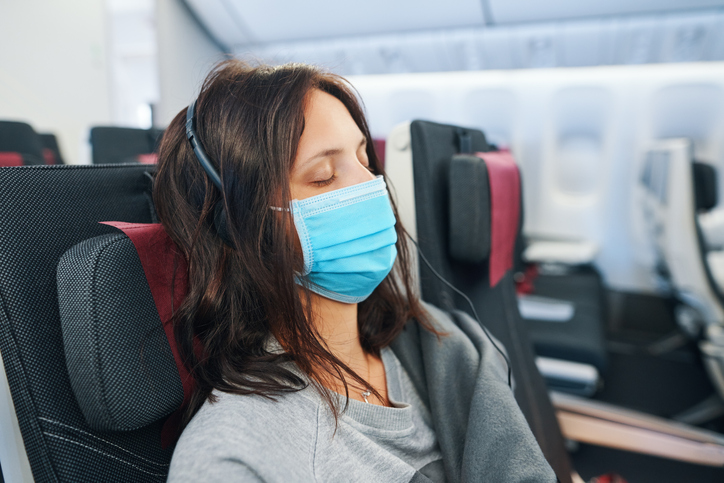
Motion sickness happens when the movement you see is different from what your inner ear senses. This can cause dizziness, nausea, and vomiting. You can get motion sick in a car, or on a train, airplane, boat, or amusement park ride. Motion sickness can make traveling unpleasant, but there are strategies to prevent and treat it.
Preventing motion sickness without medicine
Avoiding situations that cause motion sickness is the best way to prevent it, but that is not always possible when you are traveling. The following strategies can help you avoid or lessen motion sickness.
- Sit in the front of a car or bus.
- Choose a window seat on flights and trains.
- If possible, try lying down, shutting your eyes, sleeping, or looking at the horizon.
- Stay hydrated by drinking water. Limit alcoholic and caffeinated beverages.
- Eat small amounts of food frequently.
- Avoid smoking. Even stopping for a short period of time helps.
- Try and distract yourself with activities, such as listening to music.
- Use flavored lozenges, such as ginger candy.
Using medicines for motion sickness
Medicines can be used to prevent or treat motion sickness, although many of them cause drowsiness. Talk to a healthcare professional to decide if you should take medicines for motion sickness. Commonly used medicines are diphenhydramine (Benadryl), dimenhydrinate (Dramamine), and scopolamine.
Special Consideration for Children

Motion sickness is more common in children ages 2 to 12 years old.
Some medicines used to prevent or treat motion sickness are not recommended for children. Talk to your healthcare professional about medicines and correct dosing of medicines for motion sickness for children. Only give the recommended dosage.
Although motion sickness medicines can make people sleepy, it can have the opposite effect for some children, causing them to be very active. Ask your doctor if you should give your child a test dose before traveling.
More Information
Motion Sickness in CDC Yellow Book
File Formats Help:
- Adobe PDF file
- Microsoft PowerPoint file
- Microsoft Word file
- Microsoft Excel file
- Audio/Video file
- Apple Quicktime file
- RealPlayer file
- Zip Archive file
Exit Notification / Disclaimer Policy
- The Centers for Disease Control and Prevention (CDC) cannot attest to the accuracy of a non-federal website.
- Linking to a non-federal website does not constitute an endorsement by CDC or any of its employees of the sponsors or the information and products presented on the website.
- You will be subject to the destination website's privacy policy when you follow the link.
- CDC is not responsible for Section 508 compliance (accessibility) on other federal or private website.

Unconventional Hacks To Get Rid Of Seasickness On A Cruise
I f you're a person who experiences seasickness when you're on the water, a vacation cruise can seem like anything but fun. Nobody wants to be holed up with a trash can while their travel buddies are chilling around the lido deck or throwing back tropical drinks. Even if you've got a train case full of seasickness medications for your cruise, it can come with some fairly unpleasant side effects — like completely knocking you out or causing significant eye dilation that can interfere with your ability to focus. But the good news is that plenty of folks manage to negotiate their queasiness and actually enjoy themselves enough to take advantage of everything a cruise has to offer. That's because travel veterans understand that managing seasickness doesn't involve a panacea — sometimes it comes down to throwing everything but the kitchen sink at it.
Because everyone is different, we've combed through everything from Reddit recommendations to evidence-based research to find plenty of solid suggestions for banishing this all-too-common travel woe. When in doubt, try a little bit of everything and see what works best for you. Next time you're traveling on the water, don't forget to try out these unconventional hacks for staving off seasickness.
Read more: 15 Reasons You Should Never Take A Cruise
Change Your Surroundings
When you're feeling queasy, holing up in your stateroom can seem like the best of all bad choices. And it can be a real drag to spend your seafaring vacation looking at four walls. While it may feel counterintuitive, forcing yourself to get up and stretch your legs above deck in the fresh air can actually help calm your seasickness.
It's a suggestion that comes up again and again on Reddit , particularly on forums with folks who have extensive experience on the ocean. One Redditor recommends, "Stay above deck, get some water, and stay moving and you'll feel much better much sooner." Echoing the sentiment, another user advised, "You need to get above decks and lock eyes on land."
That's because getting out of cramped quarters and above deck exposes you to fresh air, which both research and doctors' anecdotal experience demonstrate can help with symptoms of seasickness. According to a study by Temperature, motion sickness has been shown to directly impact the body's thermoregulation, causing the body temperature to drop. Perhaps somewhat paradoxically, this causes the ill person to become flushed or even hot as their body attempts to regulate their temperature. Fresh air can help to reset the system while you gradually become physiologically accustomed to the new status quo.
Be Conscious Of Your Triggers
Like all forms of motion sickness, seasickness isn't a one-size-fits-all ailment. Individuals suffering from seasickness can even have their own unique triggers — the key is in trying to understand what yours are so you can avoid them. Every time you experience an uptick in motion sickness, try working through some of the things that might have caused it so you can potentially mitigate future problems.
Just as looking out a side car window can trigger motion sickness, it's possible that looking at certain things could make your seasickness worse. Fatty and greasy foods are also thought by many experienced sailors to be a contributing factor for some folks. If this is the case for you, it's probably best to skip the cruise ship buffet altogether in favor of lighter fare. Others will swear that drinking caffeine can intensify a person's motion sickness, so switching to half-caf for your morning latte while on vacation might be worthwhile. And if you're the kind of person who experiences motion sickness when you try to read in a car, you might be better off switching to audiobooks for your vacation. Crowds, dehydration, exposure to secondhand smoke — whatever your triggers, the key to reducing their effect on your vestibular system begins with identifying them so you know what to avoid.
Maintain Healthy Habits
While it's always a good idea to keep up with healthy lifestyle habits, taking good care of your body can affect the way you handle motion sickness. And there's a ton of data to support this. For starters, make sure to get plenty of sleep while you're on your cruise. A 2016 study in Autonomic Neuroscience concluded that sleep deprivation could reduce individuals' ability to adapt to motion sickness while having an additive effect in terms of motion sickness severity. In other words, getting enough sleep can help you to bounce back faster.
If you're a smoker and you know you suffer from seasickness, this could be the excuse you need to cut back before your trip since smoking has also been found to affect motion sickness. In a 2010 Autonomic Neuroscience study, researchers found that short-term smoking cessation helped to reduce motion sickness symptoms. This is backed up by the CDC recommendation that "Quitting (even short-term) reduces susceptibility to motion sickness." And not to be a buzzkill, but slowing down on the booze can also help to reduce motion sickness — which kind of makes sense since drinking enough can literally give you the spins. This is because alcohol does a number on your vestibular system — the mechanism in your inner ear that helps you maintain your balance and interpret motion and your body in space.
Take Some Ginger Or Mint
Ask just about anyone who has experienced pregnancy-related nausea, and they'll likely tell you that ginger can be a godsend for managing pretty intense queasiness. According to Johns Hopkins Medicine, that's because ginger contains gingerol, a type of compound with so many naturally occurring health benefits that it's not hard to see why some folks swear it's nature's miracle cure. Experts say ginger helps to stave off nausea by encouraging gastrointestinal motility — in other words, it gets your intestines moving things along a bit more efficiently. It can also help to cut down on gas and bloating you might experience when you start to feel a little better and decide to hit the buffet. And that's to say nothing of gingerol's antioxidant properties or association with anti-inflammatory and pain-relieving effects. Whether you're already a bona fide ginger lover or can't stand the flavor, there are plenty of ways to take it, from ginger teas and candies to easy-to-swallow ginger capsules.
If ginger doesn't work for you, try adding some peppermint to your diet, which also may help to ease motion sickness. As an added bonus, studies have found that chewing gum can have a mitigating effect on visual-related motion sickness. If staring at waves is causing you grief, picking up a pack of peppermint gum might be just what the doctor ordered.
Give Your Eyes A Break
Even on vacation, most folks are glued to their phones these days — it's just a fact of life in the modern age. But if you're prone to seasickness, think of it as the universe giving you a sign that it's time to take a technology break. Just like reading a book can have a multiplying effect on motion sickness, so can looking at your phone.
Although researchers are only just beginning to understand the issue, prolonged screen usage is becoming increasingly associated with a condition called cybersickness. According to Iowa State University, "Cybersickness refers to a cluster of symptoms that occur in the absence of physical motion, similar to motion sickness. These symptoms fall into three categories: nausea, oculomotor issues and general disorientation." And it doesn't take a neuroscientist to understand how this could play out for someone already suffering from seasickness.
Even if you're not looking at a book or phone, experts say focusing your eyes on a single point along the horizon can help your brain process the motion of the ocean. And there are plenty of folks who swear by this. As one Reddit user put it on the excellent Explain Like I'm Five subreddit , "It gives your mind a frame of reference to determine exactly what is level. When you know what 'level' is, your brain can deal with the motions reported by your inner ear." And when you're truly desperate, it's never a bad idea to take a midday nap.
Listen To Music
Music can be soothing under the worst of circumstances, so it makes sense that breaking out the headphones might help you calm an unwieldy vestibular system. That music can reduce motion sickness has been well-proven, with many studies supporting the relationship, according to Drugs in Context's research overview. According to the authors, one study "found that the mean motion exposure time in minutes tolerated before the onset of nausea was significantly longer for music." And it's not just any old music.
Researchers publishing in Applied Ergonomics looking at visually induced motion sickness (VIMS) found that pleasant or relaxing music has a reducing effect on the condition. The study assigned listeners to groups that listened to either no music, stressful music, neutral music, or relaxing music before immersing them in a 14-minute bike ride video and following it up with a motion sickness study. The researchers concluded that among the four groups, only relaxing music had a reducing effect on the participants with one caveat — that the music had to be perceived as pleasant by the listener. To try this out for yourself, download a relaxing playlist ahead of your trip and bring some good noise-canceling headphones along for the ride.
Try Some Lavender Or Aromatherapy
Lavender and other aromatherapies have been extensively studied for their effects on various types of nausea. In particular, lavender reduces nausea in individuals with several conditions, including pregnancy and postoperative nausea. Like their edible formats, peppermint and ginger fragrances seem to have medicinal properties when used as aromatherapy. Since using these complementary therapies tends to be generally relaxing, you can't lose by trying them unless you happen to be allergic or sensitive to the smell.
If this is your first time using aromatherapy, Healthline advises using caution and discontinuing if you experience an adverse reaction. Better yet, it's probably a good idea to try out new aromatherapy before you find yourself stranded in the middle of the ocean with hives on top of motion sickness since cruise ships don't always have complete medical facilities.
To use aromatherapy, you can either inhale essential oils directly or bring along a travel diffuser. Alternatively, add a few drops to your toiletries or try mixing them with carrier oil so you can dab them in hot spots like behind your ears or the back of your neck.
Try Deep Breathing
For most folks, it only takes one bad hangover or bout of norovirus to learn that deep breathing is one of the best ways to slow down the nausea train. Researchers say there's even a best practice for deploying this tried-and-true method for calming the uneasy gut. A 2015 study in Aerospace Medicine and Human Performance found that controlled, diaphragmatic breathing was associated with reports of reduced motion sickness after viewing footage of a boat on rough seas through VR.
Researchers associated with the study believe this type of breathing maximizes an individual's parasympathetic nervous system tone. Put another way, it helps to relax all those fight-or-flight systems that make nausea and motion sickness even worse. It can even help to induce sleep when it's time to crash for the night or help reduce your perception of pain — both things that may become an issue if your motion sickness gets gnarly enough. The good news is that it's a technique even preschoolers are capable of learning, so just about anyone can master it.
To try it out, start by breathing at your usual rate. Be sure to inhale through your nose while breathing out through pursed lips. Count each breath in your mind, beginning with "in, two, three" on the inhale and "out, two, three" on the exhale. This will help you to regulate your breaths, increasing your oxygen while lowering your blood pressure and causing overall relaxation.
Take An Antihistamine
Even if you don't suffer from allergies, an antihistamine could turn out to be a real game changer on your cruise vacation. Promethazine, also called Phenergan, is a relatively strong prescription antihistamine that has long been used to combat nausea in hospital and healthcare settings, but it turns out that you can get many of the same benefits in an over-the-counter antihistamine like Benadryl. While some travelers advise that Benadryl is shorter-acting than a motion sickness med like Dramamine, they see this as a feature and not a bug since this means it will take effect pretty quickly.
Even so, it's probably best to consider this a last resort. Like many other seasickness medications, an antihistamine like Benadryl will likely make you sleepy or, in some severe cases, even knock you out. But as one wisecracking Reddit commenter put it, "Can't get sick if you're asleep." Wise words.
Use Visuospatial Training Exercises
File this one under "extra homework." For folks who are seriously invested in conquering their motion sickness, some experts say visuospatial training exercises could be the key. In 2021, a group of researchers published their work in Applied Ergonomics on what they called a "novel visuospatial training tool," and the results look promising. The authors conducted a study that looked at motion sickness in both on-road and driving simulator trials. Participants took part in 15 minutes of pen-and-paper tasks each day for 14 days aimed at improving their visuospatial skills.
According to the study authors, participants' visuospatial skills had improved by 40% by the end of the training period, which they concluded was "directly responsible for a reduction in motion sickness." Although the study's authors did not share their specific recipe for visuospatial magic, examples of similar exercises are fairly easy to find with a simple Google search.
Take A CBD Supplement
The anti-nausea benefits of cannabis are widely known, but not everyone realizes they don't have to catch a buzz or use any substances that could cause trouble in their workplace to take advantage of these benefits. Cannabidiol (CBD) is an incredibly beneficial chemical found in the cannabis plant, and it can be purchased just about anywhere these days. That's because it doesn't contain tetrahydrocannabinol (THC), the psychoactive chemical that an overly enthusiastic DARE officer warned your class about back in the day.
According to the British Journal of Pharmacology, "The anti-emetic effect of cannabinoids has been shown across a wide variety of animals that are capable of vomiting in response to a toxic challenge." Since CBD has also been found to decrease anxiety at just about any dose, this knocks out two of the most aggravating aspects of seasickness in one punch.
CBD can be taken in several ways, including as a tincture, capsule, lozenge, gummy, or spray — just to name a few. If you're choosing to make your purchase online, be sure you're purchasing from a reputable retailer.
Try Using Acupressure
If you've never had a reason to try acupressure, consider checking out acupressure solutions before you set sail since they can offer real relief for some folks. And it's not just anecdotal — acupressure is an alternative medicine solution that has been proven to help with seasickness. Researchers in a 2001 study in Alternative Therapies in Health and Medicine found that the pressure on the P6 point (also called the Neiguan point) was linked to "significantly fewer symptoms of motion sickness" and "less abnormal gastric activity" than subjects experienced on control days. This is backed up by a 2017 Journal of PeriAnesthesia Nursing study that found P6 acupressure had a mitigating effect on nausea intensity while aiding patient comfort. That's probably why it's been practiced in China for thousands of years.
If you're planning to try it out yourself, there are a few things to consider before getting started. You should only perform acupressure on healthy, unbroken skin — avoid using it on skin with a rash, open wound, blistering, peeling, warmth, swelling, redness, or another form of damage. Many medical institutions and hospitals offer online video guides to reducing nausea through acupressure. After you've found one you like, be sure to download it to your phone so you've got it handy when you need it on your trip. And don't forget to practice ahead of time since having that muscle memory could mean all the difference when the ocean starts to do its thing.
Roll Yourself Into A Burrito
If all else fails, you can always embrace the "burrito" hack for reducing your sense of motion in space , a tip that's nothing short of brilliant. The idea is to create a sort of DIY cocoon that shuts you off from the sensory overload you've been putting your body through long enough to reset your vestibular system.
To make it happen, you'll need to grab your cabin's lifejackets, shoving them underneath your mattress to lift one side of your bed, forming an angle against the wall. This gives you your very own little burrito-like hideout to escape from the constant back-and-forth of the ship's horizontal motion. Nestled cozily between the mattress and wall, you don't have to worry about getting rolled around, leaving you free to chillax and work on hard-restarting your wave-weary vestibular system. Now all you need is to slap on some lavender aromatherapy, pop a CBD gummy, and break out the Chopin playlist — a few hours of sleep in your cabin burrito, and you'll be right as rain.
Read the original article on Explore


IMAGES
VIDEO
COMMENTS
A powerful motion sickness treatment, Dramamine is a must for your cruise medicine kit. This over-the-counter medicine counteracts nausea and dizziness via active ingredient Dimenhydrinate. A ...
What is the Best Medicine for Cruise Motion Sickness? While prevention is the best defense, there's a wide range of options to find the best medicine to take on a cruise. Between over-the-counter, like Dramamine and Bonine, to prescription-strength, such as Scopolamine patches and suppositories, and various alternatives like acupressure bands ...
Below, we compare two popular brands of motion sickness medicine: Dramamine versus Bonine. Note: Dramamine and Bonine both offer several versions of pills and tablets to fight seasickness.
Those who experience motion sickness in cars, planes, or roller coasters are already familiar with the feeling of being seasick. Seasickness is a form of motion sickness that occurs when there is a discrepancy between the motion of the ship, visual input, and the vestibular system in your inner ear.
Luckily, cruise lovers have an array of options for seasickness prevention, from medicines and seasickness patches to Sea-Bands and even cabin-booking tricks that can alleviate motion sickness ...
The best motion sickness medicine for cruises will be different for everyone. All our ships are well-stabilized and bear plenty of weight so most guests don't even feel like they're moving. That said, certain guests may be more prone to feeling motion than others — like they would in a car or plane. While some find relief with devices ...
6. Seabands. A favorite cruise essential for many, seabands are wristbands that alleviate motion sickness symptoms. They work with acupressure buttons to prevent symptoms of seasickness and many cruisers have very good results. Seabands are natural and contain no medication, plus, they're reusable.
Ultimately, Bonine effectively prevented motion sickness due to mild motion, such as car travel, while Dramamine was effective against moderately intense motion. The researchers did not recommend either drug for severely intense motion. Likewise, neither drug was found to be effective after motion sickness already developed.
Key takeaways: Several medications can help with nausea from motion sickness. They work best when taken ahead of time to prevent symptoms from happening in the first place. Options include prescription scopolamine patches (Transderm Scop) and over-the-counter antihistamine pills, like dimenhydrinate (Dramamine) and meclizine (Bonine).
Dramamine's original formula prevents and relieves dizziness, nausea and vomiting, all awful symptoms of motion sickness. The active ingredient is dimenhydrinate. Some people report feeling drowsy and foggy when they take Dramamine Original Formula. To prevent seasickness, a first dose should be taken 1/2 to 1 hour before a boat ride, cruise ...
Dramamine Sea Sickness Medicine is the number one doctor-recommended medicine that combines the clinically-tested ginger dosage with non-drowsy active ingredients to soothe an upset stomach quickly, so you can enjoy your cruise without any worries. Infused with natural ginger, this sea sickness medicine helps prevent nausea, vomiting, and ...
To reduce motion sickness, choose a stateroom in the middle of the ship on a lower deck. You will feel any sway of the ship less in this section. Although it may seem counterintuitive, if you're worried about seasickness on a cruise, book a stateroom with a window or a veranda. Fresh air access and a horizon view will help alleviate ...
However, it is also useful for motion sickness, as you might experience on board cruise ships. The medication contained in the patch is slowly released into the wearer's system over the course of three days. It works through the central nervous system to calm the digestive system. Now that you know, you might develop a case of FOMO.
If you are inclined to motion sickness but want to ensure an enjoyable cruise, take the following steps to avoid seasickness. Pack Your Medicine. If you know the rocking of the waves might upset your stomach, plan ahead by packing some medication for seasickness.
5. Eat the Right Food. Eating the right foods is one of the best ways to avoid seasickness on a cruise ship . Stay clear of heavy, greasy meals that can upset your stomach and make you more ...
Advertisement. After a few months of therapy, most people feel better and the persistent motion sensation no longer bothers them. However, another cruise — or whatever activity triggered mal de ...
How to Treat Motion Sickness. If you experience motion sickness during your cruise, there are a number of ways you can treat your symptoms. You can also prepare in advance of your cruise and pack sea sickness medication or other treatments such as a motion sickness patch or wristband in your luggage so you can access them once you are onboard.
In the event that seasickness does develop, Dr. Shore assures that it's unlikely to really interrupt your adventure, since all Royal Caribbean ships have motion sickness medications, like meclizine, readily available at the dedicated Medical Center on each of our ships, free of charge. "Additionally, for more troublesome seasickness, our ...
Dramamine Motion Sickness Relief at Amazon ($5) Jump to Review. Best Tea: Traditional Medicinals Organic Ginger Tea at Amazon ($34) Jump to Review. Best Essential Oil: UpNature Essential Oil Roll ...
Most large cruise ships are built with stabilizers to make the ride as smooth as possible. Even so, people who are prone to motion sickness can start to feel queasy onboard. Even those who never ...
Cruise ship: Book a cabin toward the front or middle of the ship. If you can, choose one on a lower level, closer to the water. Plane: Sit in the wing section. Train: Choose a forward-facing window seat. What medications help prevent motion sickness? There are over-the-counter medications that may prevent motion sickness symptoms:
Motion Sickness. Motion sickness happens when the movement you see is different from what your inner ear senses. This can cause dizziness, nausea, and vomiting. You can get motion sick in a car, or on a train, airplane, boat, or amusement park ride. Motion sickness can make traveling unpleasant, but there are strategies to prevent and treat it.
Cruise Ships. Don't assume that smaller ships are worse for seasickness than mega-ships. All ships move in waves, and the size of the ship does nothing to eliminate motion—it only changes its characteristics. Choosing an itinerary in protected water is your best bet against motion sickness.
A 2015 study in Aerospace Medicine and Human Performance found that controlled, diaphragmatic breathing was associated with reports of reduced motion sickness after viewing footage of a boat on ...